

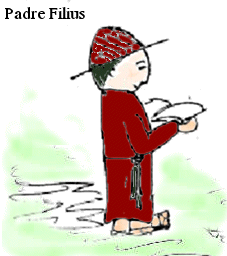
LIKE US? To Receive a Monthly DIGESTWORLD Reminder, Click the Link to Send Email Request: SUBSCRIBE
NOTE: Place Cursor over a photo for a few seconds to read text description.
== == == == == == == == == == == == == == == == == == == == == == == == == 
CLICK FLAG TO OPEN FIRST-AID KIT.
All the tools you need for a simple Speed Trace
IN ONE PLACE.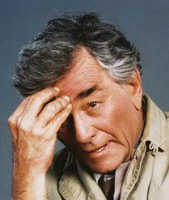
== == == == == == == == == == == == == == == == == == == == == == == == ==
~~~~~~~~~~~~~~
~~~~~~~~ In Memoriam: Peter Faulk ( 1927 - 2008) ~~~~
~~~~~~~~ Well-loved character actor and leading man, best known for his portrayal of the inimitable detective Colombo in his old trench coat, beat-up auto, and last-minute turn-around for one more question as he left the prime subject sighing with relief that it was all over, but Colombo had other plans. ~~~~~
~~~~~~~~~~~~~~
~~~ GOOD MOUNTAIN PRESS DIGEST #095 Published May 1, 2009 ~~~ == == == == == == == == == == == == == == == == == == == == == == == == ==Quote for the Merry Month of May:Corruption is no stranger to Washington; it is a famous resident.
— Walter Goodman, American Writer== == == == == == == == == == == == == == == == == == == == == ==
By Subscription only.== == == == == == == == == == == == == == == == == == == == == ==
Editor: Bobby Matherne, Asst. Editor: Del Matherne
[To Contact Editor Click Here!]
To Subscribe, Click Here or copy into your Browser
this URL: http://www.doyletics.com/subscrib.htm
To Unsubscribe, see bottom of Digest.
©2009 by 21st Century Education, Inc, Published Monthly.
To Read All of Bobby's Writings Click Here!
~~ Click on Heading to go to that Section (Allow Page First To Fully Load). ~~2000: INAUGURAL YEAR: Jun #1 Jul #2, Aug #3, Sept #4, Oct #5, Nov #6, Dec #7
THE GOOD MOUNTAIN PRESS DIGEST #095, May 2009 Archived Digests
Table of Contents1. May's Violet-n-Joey Cartoon
2. Honored Readers for May
3. On a Personal Note
4. Cajun Story
5. Recipe of the Month from Bobby Jeaux’s Kitchen: Grama Del's Tuna Fish Salad
6. Poem by Tom Lewis entitled Fair Winds and a Following Sea
7. Reviews and Articles Added for May:8. Commentary on the World
- ARJ2: Saint-Exupery — A Biography by Stacy Schiff
- ARJ2: The Influence of the Dead on Destiny, GA#179 by Rudolf Steiner
9. Closing Notes — our mailing list, locating books, unsubscribing to Digest
10. Gratitude== == == == == == == == == == == == == == == == == == == == == ==
THE GOOD MOUNTAIN PRESS DIGEST #095 == == == == == == == == == == == == == == == == == == == == == ==
ARCHIVED DIGESTWORLD ISSUES ON THE WEB ~ ARCHIVED DIGESTWORLD ISSUES ~ 
2001: Jan #8, Feb #9, Mar #10, Apr #11, May #12, Jun #13, Jul #14, Aug #15, Sep #16, Oct #17, Nov #18, Dec #19
2002: Jan #20, Feb #21, Mar #22, Apr #23, May #24, Jun #25, Jul #26, Aug #27, Sep #28, Oct #29, Nov #30, Dec #31
2003: Jan #32, Feb #33, Mar #34, Apr #35, May #36, Jun #37, Jul #38, Aug #39, Sep #40, Oct #41, Nov #42, Dec #43
2004: Jan #44, Feb #45, Mar #46, Apr #47, May #48, Jun #49, Jul #50, Aug #51, Sep #52, Oct #53, Nov #54, Dec #55
2005: Jan#051,Feb#052,Mar#053,Apr#054,May#055,Jun#056,Jul#057,Aug#058,Sep#059,Oct#05a,Nov#05b,Dec#05c
2006: Jan#061,Feb#062,Mar#063,Apr#064,May#065,Jun#066,Jul#067,Aug#068,Sep#069,Oct#06a,Nov#06b,Dec#06c
2007: Jan#071,Feb#072,Mar#073,Apr#074,May#075,Jun#076,Jul#077,Aug#078,Sep#079,Oct#07a,Nov#07b,Dec#07c
2008: Jan#081,Feb#082,Mar#083,Apr#084,May#085,Jun#086,Jul#087,Aug#088,Sep#089,Oct#08a,Nov#08b,Dec#08c
2009: Jan#091,Feb#092,Mar#093,Apr#094,May#095,Jun#096,Jul#097,Aug#098,Sep#099,Oct#09a,Nov#09b,Dec#09c
2010: Jan#101,Feb#102,Mar#103,Apr#104,May#105,Jun#106,Jul#107,Aug#108,Sep#109,Oct#10a,Nov#10b,Dec#10c
2011: Jan#111,Feb#112,Mar#113,Apr#114,May#115,Jun#116,Jul#117,Aug#118,Sep#119,Oct#11a,Nov#11b,Dec#11c
2012: Jan#121,Feb#122,Mar#123,Apr#124,May#125,Jun#126,Jul#127,Aug#128,Sep#129,Oct#12a,Nov#12b,Dec#12c
2013: Jan#131,Feb#132,Mar#133,Apr#134,May#135,Jun#136,Jul#137,Aug#138,Sep#139,Oct#13a,Nov#13b,Dec#13c
2014: Jan#141,Feb#142,Mar#143,Apr#144,May#145,Jun#146,Jul#147,Aug#148,Sep#149,Oct#14a,Nov#14b,Dec#14c
2015: Jan#151,Feb#152,Mar#153,Apr#154,May#155,Jun#156,Jul#157,Aug#158,Sep#159,Oct#15a,Nov#15b,Dec#15c
2016: Jan#161,Feb#162,Mar#163,Apr#164,May#165,Jun#166,Jul#167,Aug#168,Sep#169,Oct#16a,Nov#16b,Dec#16c
2017: Jan#171,Feb#172,Mar#173,Apr#174,May#175,Jun#176,Jul#177,Aug#178,Sep#179,Oct#17a,Nov#17b,Dec#17c
2018: Jan#181,Feb#182,Mar#183,Apr#184,May#185,Jun#186,Jul#187,Aug#188,Sep#189,Oct#18a,Nov#18b,Dec#18c
2019: Jan#191,Feb#192,Mar#193,Apr#194,May#195,Jun#196,Jul#197,Aug#198,Sep#199,Oct#19a
To Receive a Monthly DIGESTWORLD Reminder — Click Here.
== == == == == == == == == == == == == == ==
1. May Violet-n-Joey CARTOON:
== == == == == == == == == == == == == == ==For newcomers to the Digest, we have created a webpage of all the Violet-n-Joey cartoons! Check it out at: http://www.doyletics.com/vjtoons.htm Also note the rotating calendar and clock that follows just to the right of your mouse pointer as you scroll down the page. You'll also see the clock on the 404 Error page if you make a mistake typing a URL while on the doyletics.com website.
The Violet-n-Joey Cartoon page is been divided into two pages: one low-speed and one high-speed access. If you have Do NOT Have High-Speed Access, you may try this Link which will load much faster and will allow you to load one cartoon at a time. Use this one for High-Speed Access.
This month Violet and Joey learn about rhyming. Below is a poem I wrote as a prefatory note to readers of my first book of poems, "Flowers of Shanidar" in 1990. It will help illuminate the actual conversation a couple of months ago which became this month's VJ Carton.
Deli really loves it when my poems rhyme.
She says, "Can't you make it happen all the time?"
I explained that modern poetry
has well-known un-rhymed notoriety.
So, she listens patiently a while,
but only when it rhymes does she smile.#1 "Rhymes" at http://www.doyletics.com/images/042209jv.gif
== == == == == == == == == == == == == == == == == == == == == ==
2. HONORED READERS FOR May:
== == == == == == == == == == == == == == == == == == == == == ==Each month we take time to thank two of our good readers of Good Mountain Press Digest, books and reviews. Here's our two worthy Honored Readers for this month. One of their names will be in the TO: address line of your email Digest notification. Our Honored Readers for May are:
Don Cruse in Alberta, Canada
Kemper Martin in Gretna, Louisiana
Congratulations, Don and Kemper !
== == == == == == == == == == == == == == == == == == == == == == == == == == == == == == == == == == == == ==
3. ON A PERSONAL NOTE:
== == == == == == == == == == == == == == == == == == == == == == == == == == == == == == == == == == == == ==
PYRATES INVADE FRENCH QUARTER
Pyrate is the original spelling for "pirate" and is a good word to use to distinguish these authentic pirates from the hooligans and teenage thugs trying to make a quick fortune off the horn of Africa. These pyrates meet once a year to renew old acquaintances, sing sea shanties, lift a cup of rum, acquire new regalia for their pyrate clothes, and have fun. These pyrate-folk come from all over country, and a few from Canada, too, and have been gathering for the annual Pyrate Con at various sites across the country until they found the French Quarter in New Orleans a few years ago, and they've been coming back each year since. Where else can a hearty pirate drink his rum in public on the street in an atmosphere which hasn't changed much in over two hundreds years — where scantily clad wenches fill the streets whenever there is a party — where one can have good-natured fun and drink 24 hours a day — in other words enjoy being a real pyrate for a few days a year.
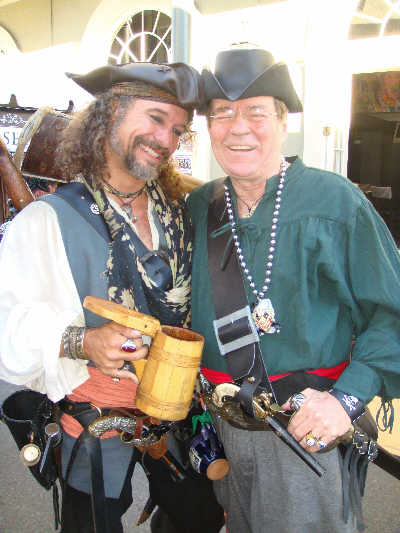
I was in California three years ago and when I said I was from New Orleans, a lady mentioned that she would be there in three months for a pirate conference and invited me to come to their parade. Del and I went to the French Quarter on that day, but saw no parade and were heading home when we stumbled upon a group of five folks in pirate gear. They told us to head to the pirate Lafitte's Blacksmith Shop on Bourbon Street and we joined the parade, and I vowed to attend the next Pyrate Con and I did. This one was my second Pyrate Con, and I'm already looking forward to 2010 Pyrate Con on the weekend of April 17 next year. Each year, I've added to my pirate costume. This year I added an over the shoulder holder for my heavy pirate sword which also came with a long-barreled flintlock pistol. There'll be a photo of me with my full gear on somewhere in this Digest. I have to admit that at times, I felt like I was a walking hardware store!
My favorite part was greeting old friends and meeting new ones. Unfortunately some do-gooders stole away some large part of the pirates from the last Pyrate Con and impressed them into His Majesty's Service doing public service work. A public service pirate — isn't that an oxymoron? I saw only one of my old friends who had jumped ship, my good friend from Toronto, Thom Barnett, who wanders around in a feigned drunken stupor in his pyrate regalia, carrying a wooden leg over his shoulder, as Thom of Bedlam — right out of King Lear. He admitted he didn't like being made to work as a pirate-slave. Probably didn't care much for marching in a warmed up leftover of a carnival parade, either. I heard about this stuff, but had no interest in watching or supporting it. My hope is this coercive impress will eventually be discontinued for lack of interest and Pyrate Con will once again reign supreme as the only pyrate event in the French Quarter.
Friends from previous Pyrate Cons who didn't come back were sorely missed, like Blackbead and his lady Melody. They chose wisely and refused to come because of this dastard schism of the pirate clan, and other faces from last year who never showed up this year, perhaps for a similar reason, such as Bryan Dunn and his lady who chose to go somewhere on the East coast this weekend. Hope we'll meet again at Pyrate Con 2010.
An old friend, Mal Morgan, came in his Captain Morgan outfit, looking very much like he stepped off a poster for Captain Morgan's spiced rum to everyone except those folks with kids who insisted on calling him, "Captain Hook". The similarity is striking, but Captain Morgan has both his hands, the better to drink his spiced rum with, of course. My art editor couldn't resist air brushing in a hook on one of the photos I took of Mal as Captain Morgan with his Lady Teri. We walked together in the Pyrate Con parade through the French Quarter. I had fun going up to and pointing my flintlock pistol directly into the video cameras of parade watchers. Something to take home, up close and personal with the business end of a pirate's gun.
My other favorite activity was watching and listening to Skip Henderson, playing on one of his several squeeze boxes, accompanied by John Blakemore on his tambourine-like drum, as they sang sea shanties and old songs of the sea. Del and I bought items from Miguel Angel, a local artisan vendor for Pyrate Con. I met Barry a French Quarter artist, who I first saw on his knees dabbing large squares of brown paint on an unframed canvas in Pirate Alley one afternoon as I headed for the Pontabla Café for an oyster po-boy. The next day, I saw the painting was complete: it was a pirate ship. I was taking a photo of it when Barry came by and introduced himself. I told him about my frigate the Grey Ghost and read him the poem, and he was inspired to paint the Grey Ghost under commission for me.
DEL'S BIRTHDAY ON EASTER SUNDAY

Our good friends Renee and Burt Lattimore had offered to have us over for dinner when their kitchen renovation was finished. Talking about possibilities for a date, I suggested the Saturday before Easter since Easter was Del's birthday this year, and we could have a little birthday celebration. The key was that since this was a pre-planned event, Del wouldn't assume it was a birthday party and we could surprise her. The big question would be: "Would she find out in advance?" I prepared myself as best for keeping the big surprise secret.
The day before the big day, I had gone to Rouse's Supermarket to buy some fresh boiled crawfish as my excuse for getting out on a long errand in the morning. Took a photo of Etta, my favorite flower lady for over 12 years. Etta helped me select the balloons, then blew them up and attached the pretty weights. Del was going to get her fingernails manicured, so I drove straight home to move the crawfish into the fridge to keep until supper. She had called me to say the manicure place was busy, so she was looking for another place. Luckily I decided to put the four foil balloons in the trunk at Rouse's. I placed the doberge cake on the floor of the passenger compartment with a cloth over it.
In our driveway, I didn't even turn the motor off so I could get back on the road immediately. As I backed out the driveway, there was Del coming to turn in, so I backed all the way out, then put my window down as I knew she'd be curious. "Where ya going?" "Errands" "What kind of errands?" "Secret errands". I knew if I lied, she'd know I was lying and worry, but by telling the truth she could wonder instead of worry, and in pleasant anticipation. I drove to Meraux to the Lattimore's to drop off the four balloons and chocolate doberge cake from Gambino's for Del's birthday surprise the next day.All went well, — as we drove up, Del saw the two balloons outside and said, "How nice of Renee!" Our Algiers point friends were right behind us and came in with a birthday gift for Del. A wonderful basket of goodies that Guntis, Annie, and Joy put together.

We had a great visit. All of our friends enjoyed each other's company. After eating the fine meal Renee had catered, topped off by a slice of doberge cake and ice cream, we walked on the levee to look at the rising water, and then sat outside alongside the pool and talked for an hour or so. Burt showed me his large garage with the 14' high doors which can shelter his son's helicopter. It's every man's dream to have such a huge garage. For me it would hold several antique cars that I would like to have. I finally sold my 1951 MG TD sports car when I realized that I wanted to have a garage for all of my cars, something I didn't have in New England where only the TD was sheltered in our garage.
The next day was Del's official birth day, April 12, 64 years to the day since Franklin Delano Roosevelt died in Warm Springs, Georgia. And it was Easter Sunday. We picked up Doris and met our youngest offspring, Stoney Hatchett, his wife Sue, and son Sam at the Timberlane Country Club for an Easter Brunch. We heard the news that Sam had given up playing baseball, the last sport he was still playing. Good news is he is beginning to focus on his schoolwork and thinking of a career as a pharmacist. This is definitely a sea change in our 16 year old grandson's life and attitude. Del and I like it.
GARDEN OF THE MONTH AND NEW OUTDOOR LIGHTS
Del has been fixing up the West Portico garden and lawn for several years, and the last judging we received an honorable mention, but this month we saw a car pull in the driveway and went outside to find the two judges pulling the Garden of the Month sign out of their trunk to place in front of our home, even though I hadn't cut the grass yet. In the Spring, I like to leave the white clover come into bloom and stay around. When I pick up the newspaper in the early morning, or have a "garbage moment" at dusk, I like to pause and search for a four-leaf clover among the myriad of three-leaf clovers. If I mow them, it takes another week for the clover to come back, and as soon as the cool days end, they will stop growing and the St. Augustine grass will take over the lawn. It's one of the perennial miracles of New Orleans lawns — all the Spring weeds which other parts of the country people buy weed-killing chemicals to soak their lawns, we here simply wait a few weeks and the St. Augustine takes over without weed killers, fertilizers, or aerating or any special lawn care — just mow and glow over the beautiful expanse of unbroken green. And our unbroken green is now broken by a large sign proclaiming it as "Garden of the Month."

Another thing about Del. She usually doesn't request a coffee when I take my morning break from writing and drive 15 minutes to PJ's Coffeeshop to buy my café latte. But I started offering her some of the foam which is left in the cover and the sides and bottom of the cup when I get home, and now she looks forward to it. Before leaving for PJ's I will usually check if she will home when I get back so that I will be sure to save some foam for when I get home. Soon, the phrase came to me, a takeoff of the famous phrase from the movie E. T. who was always wanting to "phone home." Now we call it "foam home" when Del knows she will be home and waiting for her spoon or two of foam. Great thing about foam is that it is mostly all air, but has the delicate texture of ice cream in the mouth.
Our outdoor lights which grace the front of Timberlane on its West Portico are working fine, but after 30 plus years, they are getting in need of another cleaning and painting. This is something I did about 10 years ago, and this time we decided to replace them with brand new fixtures from Bevolo's in the French Quarter. Their store is next to the parking lot we use when we go down to Antoine's and other places, so we have passed by it many times. A couple of months ago we got some rough estimates for replacing our lights, and this past month, we went downtown for the French Quarter Fest, parked in our usual lot, and went in and selected and ordered our new lights and a new mailbox. Bevolo makes lamps on order from 22 plus countries all over the world, lamps of all sizes and shapes. They will even custom make lamps, if you desire. We talked to Chris Bevolo and he knew exactly the size we needed to fit our house, and they will be fabricated for us and delivered to the West Bank at a location near us in two weeks. Then the Maintenance man (who looks suspiciously like Bobby Jeaux, yours truly) will have the job of installing them.
The Maintenance man was also busy assembling several new tables for the West and South Porticos. One of the tables needed to be returned to Lowe's because the factory had painted the thick protective coating over seven of the eight holes, making it nearly impossible without a threading tool to get the bolts started without stripping the threads. We returned that one in exchange for nesting tables already assembled. The nesting tables accompany the new teak rockers on the West Portico where the wind rarely blows as strong as the breezeway swing and is another great place for reading.
VISITORS TO TIMBERLANE
This month Del's mom, Doris, came over for several visits. She is a pleasure to have visit. Her physical health has improved dramatically, so she rarely tires out quickly as she did for several years after her back operations. Unless you ask questions which require memory, you would never know she had any memory problems. She is playing bingo with the residents at Woldenberg Retirement Village, something she never played before. The long evacuation trip to Monroe last September caused her to have to interact with the residents of her ALZ section and now she even has a couple of friends.
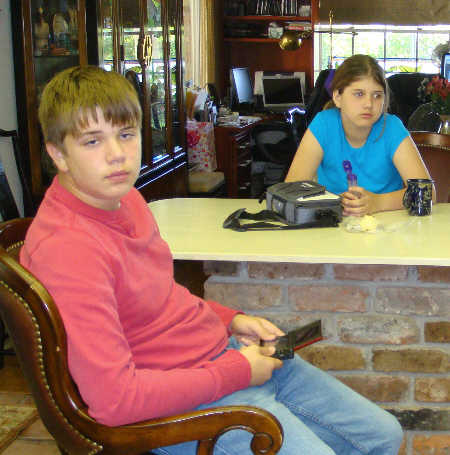
The other visit was from our daughter, Kim, her son, Thomas, his friend, Nancy, and Kim's daughter, Katie. They spent a couple of nights and Del went with them to the Audubon Zoo where they had a great time. Del, Kim, and Katie spent time poring over the New York City brochures in preparation for Katie's graduation trip to the Big Apple with Mom and Grama. Del had asked Katie where she would like to go for her graduation, and this was her choice.
HORNETS STING; TIGERS CLAW
This has been a busy month for sports with the New Orleans Hornets making the NBA Playoffs, and the LSU Tigers sitting atop the National Ranking for College Baseball most of the year. With the problems that the on-line Geaux Zone video broadcast at LSUSports.net was having, I canceled my annual subscription. After suffering through several years of birth pains during start-up, the screen going blank, halting, losing audio, ending the game abruptly, or doing a host of other glitches, I had great expectations for this year. But instead this year was a lugubrious pip!
Perfect video all through most of the games. Wow! Problem fixed. But along with the video fix came awful commercials. And an even sadder log-on procedure which every single game caused me to miss the first pitch or batter on video! Often I would have to log on with ID and Password five to six attempts before I had jumped through the hoops necessary to watch the game, all the while trying to keep track of the game on audio via the RADIO! I kept trying, figuring this was more of their startup woes, but it never got better. I wrote emails to Customer Support every time and nothing got better.
One day, I even got video from the baseball game and audio from a gym practice with some female coach yelling across a gym and making announcements! Then they broadcasted the Georgia game from Athens in video, which was okay because I figured to listen to Jim Hawthorne's broadcast on the audio process, but NOOOO! — that would have been too simple, they decided to broadcast Univ. of Georgia's audio feed. When I switched to RADIO, I heard Jim Hawthorne calling the game two swings or more before I saw it on video, pretty useless. Like instant replay without instantaneous play.
Oh, and this year JUMP TV installed Instant Replay of good plays, but it took them almost six games to notice that the audio feed of the Replay was being broadcast over the live audio feed of Jim Hawthorne's crew, making both impossible to hear clearly! Even though I sent a feedback to Customer Support the first time it happened. I got back an answer which was non-responsive — by then I was sure JUMP TV never listens to or watches its own broadcasts. None of the major problems I complained about were ever fixed.

Here was the last straw and which made me finally decide to cut the cord: They began putting up a forced video screen advertising some LSU gear with a message saying "Video will start in 0 seconds." Well, the video never started! It just sat there and whatever I clicked on the screen sent me to the full page ad. I complained about this and never heard back. It hung like this only on Vista and not on XP, but by this time, I wanted to watch games only on my Vista HP Laptop, and that was the one the game would not work on! Like MR GO, MR GEAUX is gone. I celebrate now the ease of delight of turning an LSU baseball game by pushing one button on the RADIO. JUMP TV can go JUMP as far as I am concerned! As far as I'm concerned LSUSPORTS.net no longer exists as it has no products that I'm interested in purchasing.
END OF THE MONTH STUFF
We went through a strange day in which a grand-daughter, a daughter-in-law, and a son had a mysterious cyst or blockage which they were concerned about and which have all gone away since. In addition several of Del's friends in the garden club had some kind of ailment, and our good friend Rosie Harris came down sick with some kind of intestinal ailment and needed hospitalization to keep her from being dehydrated. All are well again, but that left us wondering whether Friday the 13th had come on a Monday perhaps.
The last week of the month was the anniversary of the death of William Shakespeare which has been marked in New Orleans for over a hundred years by the Shakespeare Society with its annual dinner in the Rex Room of Antoine's Restaurant in the French Quarter. I attended and I expected to read only a female part and found a male part added to my assignment, and my two parts have a dialogue to do at one spot. Talking about accessing one's female part. This was a challenge which I get to reprise during our reading of the play in front of my club next week.
Last minute addition, we met old friends, Mike and Mary Rode from Wisconsin, in the French Quarter at the New Orleans Cooking School. It was great seeing them again. Mary knows Del's favorite boss, Michelle Holzmann, and I was reminded of the night we took Michelle to Genghis Khan Restaurant. When the waiter brought the fish to her, Michelle was appalled that its head was still on. I mentioned that incident to Mary and she responded as if she had been there with us when it happened. At the Cooking School, we sat next to a young lady who works for Mayor Bloomberg in NYC and Del was able to get some tips on places to visit when she and Kim take our grand-daughter Katie to the Big Apple in June.
TILL NEXT MONTH
Next month we look forward to the first communion of our grandson, Collin, and celebration of Mother's Day with Del's mom, Doris. Also it will be harvest time for our vegetable garden with green beans, okra, creole tomatoes, cucumbers, and bell peppers adding to the largesse of radishes which has already started. The fall broccoli has now gone to seed and those seeds will be planted about July 1 to give us broccoli over the winter months and into 2010.
Two thousand and ten — say it aloud — sounds strange, doesn't it? Get ready, it's coming. Like next month, June, when, God willing, and the river don't rise much further, we will meet you again, Good Readers, in our next Digest.~~~~~~~~~~~~~~~~~~~~~~~~~~~~~~~~~~~~~~~~~~~~~~~~~~~~~~~~~~~~~~
IMPORTANT MESSAGE:
To those Good Readers who are puzzled by How the Moon could be Rising In Front of a Mountain, Click on Photo. To see 161021 photo, Click Here. ALSO: if you are puzzled because you No Longer get our Monthly Reminder, you may have Changed Your Email Address without notifying us. NOTIFY US NOW by a simple Click Here!
Here's the Sting:
You will NOT receive a Monthly Reminder unless you have Re-subscribed under your new address to DIGESTWORLD.If you've already receiving DIGESTWORLD Reminders, ignore this message.
If you're not subscribed, and would like to Subscribe to DIGESTWORLD Reminders to receive one short email a month to inform you of the latest ISSUE, now's a good time. SUBSCRIBE NOW
by Clicking Here.Yes, this message does no good to those who changed their email address without notifying me — but it can alert those of you who are going to change your address.
If you've changed or are planning to change your email address, Click Here to SEND NEW ADDRESS. (Alternate way is to copy into your Browser this URL: http://www.doyletics.com/subscrib.htm )
EASE OF VIEWING NOTES:
NOTE: For Internet Explorer Browsers, DIGESTWORLD is best viewed at 100% Zoom and the Window's width sized so that Digest Archives lines are single-spaced, just barely. Adjust Window width so that Mountains almost touch the Archive Numbers, especially if you find some Photos overlapping text.PHOTO CAPTIONS (CURSOR FLYOVER ISSUE RESOLVED):If you have been enjoying the photos in DIGESTWORLD, but have wondered who or what you were looking at, you will now be able to hold your cursor still over the photo and the photo's description will appear. (Test on Butterfly-Crab Image at Right.) We spend a lot of time writing these photo captions and hope you will read them. All the Archived Issues have been updated to provide descriptions when your cursor rests for a second on a photo. Note that older Reviews have not been updated. If you haven't finished reading text when description disappears, move cursor away and back on photo to finish. We thank you for your patience and hope this pleases you.
New Quotes Added to quotes.htm this month:
- My desire for knowledge is intermittent, but my desire to bathe my head in atmospheres unknown to my feet is perennial and constant.
Henry David Thoreau (American Naturalist, from his Excursions)New Stuff about Website: Five Books on Writing by Men Authors
1. Noah Jonathan Jacobs 's
The Toils of Language
From the pomological scandal in Eden to the metaphysician of the privy seat (Rodin's Thinker) to the blessed warm mental fog of Conrad — the reader is treated to a cornucopia of scrupulously coined phrases and fresh quotations from thousand of years of authors.
Jacobs, leaving no one un-touched by his coruscating etymology, uncovers for us that Jacob means heel, from the story where Jacob followed on the heels of Esau (in the birth canal). An interesting sidelight for me is that my replacement in a job years ago was named Jacob — he was a heel and he followed on my heels.
Dictionaries are the cemeteries of forgotten words, where they constitute more than one-fifth of the total number. Jacobs seems intent in the course of this 125 page book on exhuming many of those words. Examples are tantivy (a hunting cry), swink, yuly, tweedle, and accismus. He re-livens the quotidian word janitor by reminding us of its roots in Janus, god of doors and entrances.
He tells us of Pro-metheus (fore-thought) who stole the fire (intuition) from the gods for the good of men and Epi-metheus (after-thought) who opened Pandora's Box. The unleashing of the plagues on mankind that afterthought started goes on today. The news media revel in after-the-fact examination of motives. Projections of the future from these examinations fill newspapers and airwaves daily with doom and gloom to as great an extent as the plagues unleashed from Pandora's Box.
With a little Promethean insight into the dangers of Epimethean afterthought, we might be allowed the space to hope in cheerful expectation of a tomorrow brighter than today.
2. Joseph Epstein's The Middle of My Tether
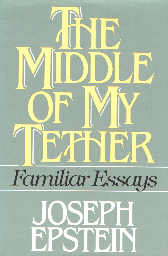
The idiomatic expression "at the end of my tether" refers to being at the extreme limits of one's abilities or endurance. This book represents Joseph Epstein squarely in the middle of his tether with ample room to amble about. This book is a random walk with Epstein through some of his favorite subjects, "About Face", "Ephemeral Verities", and "Bookless in Gaza", and a random walk with Epstein is like dancing lessons from God.

We discover that Epstein loves books (he reads while walking as Macaulay did). In his own words, "Books are an addiction that, when aroused in earnest, is rarely calmed." His attempt to survive an entire day without reading ("nothing but stop signs") is humorous to those of us suffering the same affliction. We laugh when he confesses, "my afternoons, evenings, and weekends were all booked."
Epstein gets letters and reveals to us that the arrival of the postman is a highlight of his daily routine. He bemoans the fading away of letter writing and shares with us a sample of the letters (kind and unkind) he has received. He also shares his favorite quotes from men of letters in response to angry letters they have received:
Voltaire — "Dear Sir, I am seated in the smallest room in the house. Your letter is before me. Soon it will be behind me."
H.L. Mencken's pre-printed postcard — "Dear Sir or Madam, you may or may not be right."
In "You Take Manhattan" he points out that Manhattan is a great place to visit, a great place to live, and a lousy place to write. Most writers leave the city for the seashore and other faraway places to do their best writing. He quotes Walt Whitman, "a great place for harvest, but a poor place for farming."
Some of the best parts of the book are his collection of quotes. An example is his quote of Desmond MacCarthy, "It is the business of literature to turn facts into ideas." He has done just that in this book. And when the dancing is over and the music has faded away, you may start looking for an order blank to sign up for the next set of lessons.
"We are cups constantly and quietly being filled. The trick is knowing how to tip ourselves over and let the beautiful stuff out." Letting the beautiful stuff out is like an archer releasing a bowstring so that his soul flies straight to the target as Eugen Herrigel explained so eloquently in his Zen in the Art of Archery. As the use of the title indicates, Bradbury's writing borrows freely from other authors.
When Bradbury was sent to Ireland by John Huston to write the screenplay for Moby Dick, he couldn't wait to leave the country. Only years later did he find himself recovering the images and magic of Ireland in stories and plays he wrote. He likened the literary process to Perseus confronting Medusa. If he looks at her straight on, he will be petrified and unable to speak, but if he observes her by reflection, Perseus is able to act. Thus also the literary act is one of reflection and the amount of time required for the reflection will depend on the depth of the image. For Gertrude Stein it took fifty years before the image of the little drunk girl in the slums of London to surface as a search for Gertrude's own identity. In Bradbury's book he describes the various time delays of raw images and the books he created from those images.
"All arts, big and small, are the elimination of waste motion in favor of the concise declaration." This book has little wasted motion and is filled with firecrackers of insight exploding 4th of July all over the lawn.
Like how he approaches creativity by treating ideas like cats. "You make them follow. If you try to approach a cat and pick it up, hell, it won't let you do it." But walk away and the cat follows you thinking, "Well, what's wrong with you that you don't love me?"
Truly Bradbury is a living demonstration of Kahlil Gibran's famous phrase, "Work is love made visible," as he pours himself, his poetry, imagination, and love into his books — including this one.
4. Sidney Cox's Indirections for Those Who Want to Write

"The good ones [writers] start off from a tradition — they do not follow one." With these words, Sidney Cox, professor of English at Dartmouth for over 20 years, begins this 139-page book. It is stuffed with insights into writing and filled to the brim with quotable quotes from various famous writers, e.g., Goethe, "fame — the last infirmity of a noble mind," but the best quotes are, like the one that starts this review, from Sidney Cox himself.

"When you have made a reader wonder until a new realization comes to him, you have done what you started out to do."
On Frost: "What he does is start people's imaginations so that they can better discover and enjoy their own actual experiences when no poet is by to provide the imagination."
"Your reader has to be assured that he is on familiar ground. The more so, the more daring your intention."
Heading for Chapter VIII:
"To take the vapor threads of possibility that run up from the earth to heaven and weave them with the warp of days."
"He is fortunate if the discrepancy between dream and possibility also deepens his sense of humor."
"... history is always going to the bow-wows but never does."
"... learn to ride the flux, and shape it a little as it flows to your fluent but positive intent. Doing so you will have your times of loving the dangerous flood you ride and guide."
"For sharing and possessing large intentions makes one either pompous, self-pitying, or humorous. Some of us show traces of all three."
"You may have always known that the most stable things in a flood is a man or woman who can ride it."
"... a person's point of view is where he looks from."
"Let no one shame you with characteristics natural to your age."
"If you want to write well, you let a subject make you its subject."
"Ford Maddox Ford, '...style, a succession of small surprises. You didn't contrive to put them there. Your style is your surprise.'"
"We need yardsticks... but yardsticks will not measure manifold motion."
5. Gary Provost's Beyond Style — Mastering the Finer Points of Writing
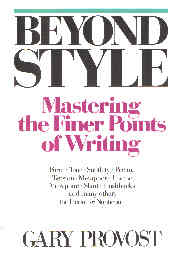
In this followup to his "Make Every Word Count" Gary Provost gives us a guided tour of creative writing that could be labelled "Make Every Word Sing." He is not satisfied with the concept that style, like life, is "what happens when you're doing something else," but feels that good writing style can be cultivated. As a writer and a teacher he reviews many manuscripts of beginning and professional writers and has developed the skill of spotting places where their writing doesn't work.
In this book on how to develop your individual style, he warns us that any technique that is obviously a technique doesn't work because it makes the reader aware of the author instead of the character or subject of the writing. One poor technique is describing the viewpoint character using a mirror or shop window reflection, "she saw in the shop window that her hips had grown wider than she imagined." Another is switching viewpoints abruptly within a single scene or paragraph. Another is inserting dialogue or description that adds no meaning to the piece.
On the positive side he suggests the use of quotes. "Credibility is believability," he says, "and everything you write, fiction or non-fiction, must have that quality." Quotes, showing that it's true, and "plants" are ways he suggests of adding credibility. Plants are basically presuppositions of other time and space actions that are created in the readers' minds by some statement. The juggler's sticks tumbled in the air like Tony's body did during a triple somersault during his college gymnastic competitions. Later when Tony does a triple somersault to foil a robbery we tend to believe it as a result of the plant while he was watching a juggling act.
"Beyond Style" is written using all the techniques that Gary suggests for writers to follow. He achieves a coherency of form and content thereby that adds credibility to his suggestions for improving style. This is an enjoyable and easy to read book that every beginning writer should have in his armamentarium. With it one can discover that what lies "beyond style" is the individual writer that transcends stereotypes to create writing that is as unique one's fingerprint and as revealing as an intimate portrait.

New Stuff on the Internet:
- New Photos:
Here's an example of a new photo which came in this month from Jeff Parsons. This and four others have been added to our Tidbits Page.
- Wanta know what we drove
what they sounded like, where we went, what we listened to while riding, and even more, turn on your sound and : CLICK
this LINK.
- Wanta learn how to do the Speed Trace?
NEW VIDEO on You Tube by Bobby Matherne, Principal Researcher in the science of doyletics: CLICK this LINK.
~~~~~~~~~~~~~~~~~~~~~~~~~~~~~~~~~~~~~~~~~~~~~~~~~~~~~~~~~~~~~~
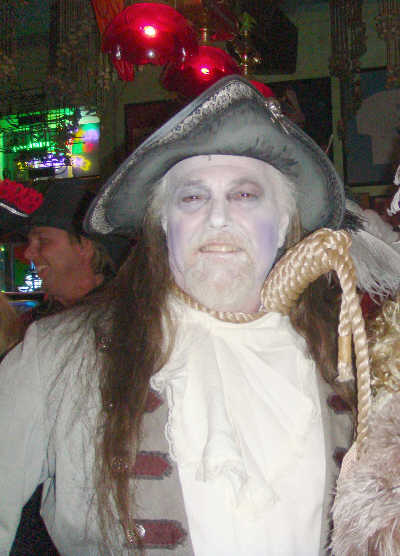
Movies we watched this past month:
Notes about our movies: Many of the movies we watch are foreign movies with subtitles. After years of watching movies in foreign languages, Arabic, French, Swedish, German, British English, Russian, Spanish, Italian, Japanese, Chinese, and many other languages, sometimes two or three languages in the same movie, the subtitles have disappeared for us. If the movie is dubbed in English we go for the subtitles instead because we enjoy the live action and sounds of the real voices so much more than the dubbed. If you wonder where we get all these foreign movies from, the answer is simple: NetFlix. For a fixed price a month they mail us DVD movies from our on-line Queue, we watch them, pop them into a pre-paid mailer, and the postman effectively replaces all our gas-consuming and time-consuming trips to Blockbuster. To sign up for NetFlix, simply go to http://www.netflix.com/ and start adding all your requests for movies into your personal queue. If you've seen some in these movie blurbs, simply copy the name, click open your queue, and paste the name in the Search box on NetFlix and Select Add. Buy some popcorn and you're ready to Go to the Movies, 21st Century Style. You get to see your movies as the Director created them — NOT-edited for TV, in full-screen width, your own choice of subtitles, and all of the original dialogue. Often you get the Director's Cut Edition which adds back excellent footage that was cut from the theater releases.Hits (Watch as soon as you can. A Don't Miss Hit is one you might otherwise ignore.):
P. S. Look for HD/DVD format movies which are now available from NetFlix.“In the Electric Mist” (2008) Gen. John Bell Hood, C. S. A., was he a figment of Dave Robichaux’s imagination or an influence of the dead on the living? Tommy Lee Jones stars in a James Lee Burke thriller in the swamps of Louisiana. A DON’T MISS HIT ! ! !
“Kismet Connection” (2008) Raj and Priya were destined to meet — it was fate, it was kismet, it was an auto crash which turns into an auto crush which takes 2.5 hours and several musical numbers to culminate. Mixed Indian-English dialogue — notice how the cuss words are cleaned up in the subtitles.
“National Treasure” (2004) wraps up the Declaration of Independence and unfurls a Hit.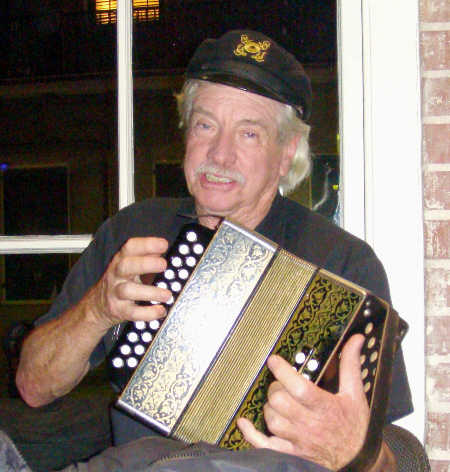 “Ciao, Professore!” (1998) a Lina Wertmüller classic about a third grade teacher from N. Italy who got assigned to S. Italy school in Napes area, the small town of Corzano, and the culture shock both the students and Maestro have to endure as they get to know each other and learn from each other. A DON’T MISS HIT ! ! !
“Ciao, Professore!” (1998) a Lina Wertmüller classic about a third grade teacher from N. Italy who got assigned to S. Italy school in Napes area, the small town of Corzano, and the culture shock both the students and Maestro have to endure as they get to know each other and learn from each other. A DON’T MISS HIT ! ! !
“Tell No One” (2006) Alex’s wife is dead and buried for eight years, but now he’s being investigated as her murderer. A loving pediatrician and grieving spouse is now being hounded by murderous henchmen and henchwoman and the police and his in-laws. And a video of his wife apparently alive shows up on his computer screen. What is going on will keep you on the edge of your seats! A DON’T MISS HIT ! ! ! !
“W” (2008) Oliver Stone does creditable job of portraying George W. Bush’s life in Texas and in D. C. His early life resembled the life that his predecessor in the presidency never outgrew.
“The Reader” (2008) ties together a sexy summer romance with a winter lady, a Nazi trial, a law seminar, the disgrace of illiteracy, and a love for reading literature aloud into an amazing DON’T MISS HIT ! ! !
“Married Life” (2007) — based on novel, “Five Roundabouts to Heaven”. See if you can pick each of them out as the movie draws to a marvelous ending.
“Mr. Brooks” (2007) A DON’T MISS HIT MAN with a handy sidekick who doesn’t eat much. A friend of Bill who never imagined such an addict as our Mr. Brooks. Hit
“The Fanny Trilogy: Disk 1, Marius” (1931 ) We see Marius’s relationship with his father, Fanny, and the sea in this movie. How Fanny gives up hope for marrying Marius so that he can go to sea.
“Frost/Nixon” (2008) shows Nixon’s path to redemption and Frost’s high-roller gamble on the interview which made him famous in the USA. A gripping duel between a newcomer and a old hand, Michael Sheen and Frank Langella and both are at the top of their game. Frost/Nixon and Sheen/Langella, superb performances, all four. A DON’T MISS HIT ! !
“A Good Year” (2006) for wine, for falling in love, for marrying a childhood sweetheart, for making a movie of a novel based on Peter Mayle’s experience he described so vividly in his autobiographical A Year in Provence. Stars Russell Crowe as Max Skinner and a cast of marvelous actors. A DON’T MISS HIT ! ! !“Evelyn” (2002) Pierce Brosnan in an atypical role as a drunken Irish singer, out-of-work house painter, abandoned by his wife who scooted to Australia, and left with three pre-teens, two smaller boys, and precocious 10-yr-old Evelyn. How can he take on the entire Irish government to take his children back out of the state orphanages? He needed a lot of angel rays and Evelyn. A DON’T MISS HIT ! ! !
“Son of Rambow” (2007) unable to watch TV or movies because of religious fanatic mom, young boy makes a friend and together they make a movie, “Son of Rambow”. These are their adventures in the endeavor and in their movie, no dog got shot! See “What Just Happened” for bad movie about making a movie.
Misses (Avoid At All Costs):
We attempted to watch these this month, but didn't make it all the way through on most of them.Awhile back when three AAAC horrors hit us in one night, I decided to add a sub-category to "Avoid at All Costs", namely, A DVD STOMPER. These are movies so bad, you don't want anyone else to get stuck watching them, so you want to stomp on the disks. That way, if everyone else who gets burnt by the movie does the same, soon no copies of the awful movie will be extant and the world will be better off.
“Seven Pounds” (2008) Will Smith worked hard in this movie, barely cracking a smile for the run of the movie. This movie justifies suicide and deserves no publicity whatsoever for that abominable feature. No one should ever get such an idea from a movie and I won’t help them by recommending this movie. I recommend anyone interested in suicide watch "What Dreams May Come" to see what happens after one commits suicide.
“I’ve Loved You So Long” (2008) Another movie like “Seven Pounds” in which the protagonist is in agony for the whole movie and we have to suffer in silence waiting for the problem to be revealed. Also this movie justifies euthanasia as a medical doctor-mother kills her son to put him out of pain as if he were a dog being put to sleep with an injection.
“Played” (2006) around with being a movie, but taco-ed.
“Shotgun Stories” (2007) were filled with blanks.
“Crooked” (2005) Hit men after a trio who escape the conversation with the flying bullets over and over again.
“X-Men 3: The Last Stand” (2006) and the Last Straw — which begs the question: “What if they developed a cure for bad movies?” We took our Stand and Stomped it promptly. A DVD STOMPER ! ! !
“What Just Happened?” (2008) we waited in vain for something fun or enlightening to happen and all we saw was DeNiro as a producer lying his way into perdition. This movie was worst than the turkey he made during the movie. Should have shot the director of that movie instead of the dog. Director of this movie, too.
“How to Rob a Bank” (2007) is a movie about how NOT to rob a bank and an object lesson in how to bore people.
“Visitor Q” (2001) a seamy and steamy treatment of taboos, none worth watching, only stomping. A DVD STOMPER ! !Your call on these — your taste in movies may differ, but I liked them:
“Donkey Skin” (1971) Change the cinders to a donkey skin covering her and the glass slipper to a ring and you have a French version of Cinderella in a musical. Deneuve !!!
“3:10 to Yuma” (2007) Will Dan Wade be placed on the 3:10 to Yuma by the one-legged Union soldier trying to redeem himself in the eyes of his son? Elmore Leonard weaves a gripping story of old West law and less.
“Redbelt” (2008) A jujitsu movie in which the owner of the martial arts studio gets deeper and deeper into debt and trouble that he has to enter the ring to fight for a big purse. But he finds out the bouts are rigged for him to win. What’s a guy to choose? Good name or good money?
== == == == == == == == == == == == == == == == == == == == == ==
Cindy, our garden helper, told me this joke:
4. CAJUN STORY:
== == == == == == == == == == == == == == == == == == == == == ==Boudreaux took Marie to the Breaux Bridge hospital to deliver the baby she was carrying. He paced nervously outside the door waiting for word. The nurse came out of the delivery room, and he jumped up, ran over to her, and asked her, “What is it? A boy or a girl?”
The nurse smiled and said, “Boudreaux, you got a little buster of a boy!”
Boudreaux yelled “Hot doggity!” and the nurse went back into the delivery. Boudreaux was heading out the door to buy some cigars at T-Bob’s Tobacco Shop, when the nurse caught up to him, “Boudreaux, you got a beautiful little girl!”
“Hooray,” Boudreaux shouted! So he stood there thinking where he could buy some chocolate to go with the cigars, when suddenly the nurse rushed back up to him and said, “Boudreaux, you have two fine boys and a girl! Triplets!” This time Boudreaux didn’t say much. He was a bit in shock, and waited to see Marie and his three new children.
About a month later when Boudreaux and Marie had just put all three of the babies to sleep, Boudreaux said to Marie, “You remember dat night when we ran out of Kentucky Jelly, Cher?”
“Mais, ouis, dat was some night. When de KY tube was dry, we had to use de 3-in-1 Oil.”
== == == == == == == == == == == == == == == == == == == == == ==
5. RECIPE of the MONTH for May, 2009 from Bobby Jeaux’s Kitchen:
(click links to see photo of ingredients, preparation steps)
= = = = = = = = = = = = = = = = = = = = = =Grama Del's Tuna Fish SaladBackground on Del's Tuna Fish Salad: Every chef has several assistant chefs, and Bobby Jeaux has a great one in Del. She always tastes his dishes before he serves them and suggests any needed condiments, and she is always right. This is her recipe for making tuna fish salad and it has become a regular on hot summer days when we want the kitchen and our bodies to stay cool. Either in sandwiches on stone-ground wheat bread, toasted or not, it makes a delicious and hearty sandwich. The finely chopped dill pickles are essential to the recipe. Also delicious served in an avocado half for each serving.
Ingredients
6 eggs
12 oz of Sunkist Chunk Light Tuna (One third of which should be canned in oil)
4 outside stalks of a long celery bunch
1 cup Blue Plate Mayonnaise
2 or 3 dozen slices of Hamburger Dill PicklesPreparation
Chop the celery and the pickles very fine, no chunks bigger than 1/4 inch or 1 cm. Boil eggs an hour or two ahead of time. (Time boil 18 minutes after it comes to rolling boil with eggs in.) Remove eggs immediately and place in cold water to cool off for at least an hour. Peel eggs. Place tuna into large mixing bowl now.To cut up eggs, nestle egg in one palm, and use knife to gently cut egg with four lengthwise strokes, rotate along long side a quarter turn, and four more strokes of knife through eggs. Then, holding palm over the tuna bowl, cut perpendicular to the length of the egg as shown in photo until all six eggs are done and have dropped over the tuna. See Photo. (Note: beginners should chop eggs on wooden cutting board to protect their hands.)
Cooking Instructions
Mix eggs and tuna until there are no big chunks of tuna. Mash the yellow of the eggs as you do this. See Photo.
Add the celery and stir to evenly distribute the celery in the mixture.
Add the pickle and mix well also.
Sprinkle well with freshly ground pepper. (When using pickles, no additional salt will be necessary.) Add mayonnaise one large heaping spoonful at a time, mixing well after each spoon. Taste after about 3 spoons. If it's too dry, add another spoon or so till it reaches the consistency you like. Note: this tuna salad will be spread on dry bread so the amount of mayo added should allow it to be deliciously moist when spread on a sandwich. See Photo of Final Tuna Salad in Bowl.
Serving Suggestions
SANDWICH: Two slices of Nature's Pride Stone-Ground Whole Wheat. Spread a generous quarter inch (1 cm) of tuna salad. Bread may be toasted or not. Works well either way.APPETIZER: Halve a California or Mexican avocado and fill to overflowing with tuna salad. Serve as a light lunch or side salad.
Other options
Leave out the tuna fish and celery, and this recipe makes a great egg salad.
== == == == == == == == == == == == == == == == == == == == == ==
Tom Lewis is an authentic seaman who writes and sing his songs of the sea. Here's a wonderful threnody for seamen everywhere to use and enjoy, with Tom's gracious persmission. Click Here to Hear Song.
6. POETRY by Tom Lewis entitled Fair Winds and a Following Sea
= = = = = = = = = = = = = = = = = = = = = =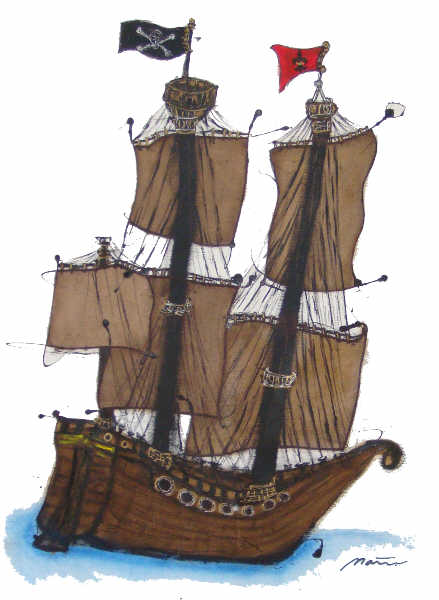
Fair Winds and a Following Sea
Words and Music: Tom Lewis ©2006May the road rise up to meet you, may the wind ever be at your back,
May you find old friends waiting to greet you, there on the outside track
We're gathered together old times to remember, 'tis but for ourselves we would grieve,
So we'll sing you a chorus and bid you farewell — fair winds and a following sea.We'll sing of 'The Leaf' and 'The Parting Glass', we'll raise up our voices in song,
No sadness today for the one who has passed, celebrate with a voice glad and strong.
A catch in the throat, a tear in the eye, but no funeral dirge will this be,
We'll roar 'Auld Lang Syne' as a victory song — fair winds and a following sea.And those of us left here will miss a true friend, who shared with us good times and bad,
Raising a glass to your memory we'll say: “We've known you — why should be we sad?”
We honour a life that was lived to the full, we honour a spirit, now free.
You'll long be remembered, whenever we say: “Fair winds and a following sea!”
You'll long be remembered, whenever we say: “Fair winds and a following sea!”
== == == == == == == == == == == == == == == == == == == == == ==
7. REVIEWS and ARTICLES for May:
= = = = = = = = = = = = = = = = = = = = = =And for my Good Readers, here’s the new reviews and articles for this month. The ARJ2 ones are new additions to the top of A Reader’s Journal, Volume 2, Chronological List, and the ART ones to A Reader’s Treasury. NOTE: these Blurbs are condensations of the Full Reviews sans footnotes and many quoted passages.
1.) ARJ2: Saint-Exupery — A Biography by Stacy Schiff
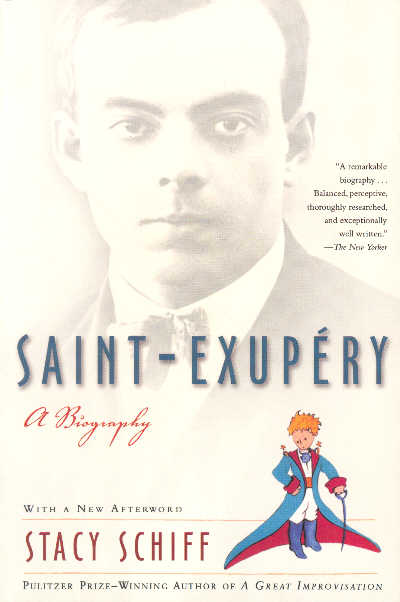
On the door going into our bathroom in Foxborough, Massachusetts was a quotation from Saint-Exupéry's classic book, The Little Prince: which said, "It is only with the heart that one can see rightly, what is essential is invisible to the eye." I read those words several times a day for over four years, and often wondered what they meant. They remain today as an unanswered question, but holding that unanswered question for over thirty years led me to seek answers to its puzzling thesis. What does it mean to "see rightly" and "what is essential" and how is it "invisible to the eye"? Only years later, seeking answers to the above questions, I discovered that these words were known as the "Fox's Secret" and I had the pleasure of watching and listening as Gene Wilder, playing the Fox, spoke those words to the Little Prince in the 1974 movie of this book.
Later I bought The Little Prince then read more of Saint-Ex's books, Wind, Sand and Stars, A Night Flight, Southern Mail, and his classic book on philosophy, Wisdom of the Sands. Among all the books, Wisdom of the Sands (original title in french was Citadelle ) impressed me the most and The Little Prince intrigued me the most. Through the process of reading this impressive biography of his life, I came to understand how the book about a young visitor from a small planet who had a problematic relationship with a rose was a very condensed version of Saint-Exupéry's life and relationship with his wife, Consuelo. Having read several of his flying novels much earlier and having never reviewed them, I decided to re-read the two I had on my book shelf and review them right at the point where I encountered Schiff talking about his writing the books, namely, Southern Mail and Night Flight. This helps account for some portion of the long time (June, 2008 to April, 2009) I spent reading this biography, but this 528-page book is both slow reading and a pleasure to read, and that kind of book begs to have its reading stretched-out for sheer enjoyment's sake.
Major X, as the Americans called him, adding to his mystery, died in his forty-fourth year, just as the little Prince he created had witnessed forty-four sunsets. (Page ix) He was a paradox in many ways: an aviator who wrote, a literary genius who piloted planes, an aristocrat (one of the de Saint-Exupéry line) who delivered the mail by air. What was it like to pilot a small single engine airplane through the night with an undependable compass and no radio? We might never know if Saint-Exupéry had not written so lyrically about his flying experiences in his novels. What was his life like, this Saint of France, as Charles Lindbergh's son asked his mother Anne? To prevent such innocent mistakes and to keep from being addressed as Mr. Exupéry, Tonio allowed his American publisher to place the hyphen between Saint and Exupéry where it stands today. His friends called him Tonio or Saint-Ex, leaving off the "oopairee". (Page xi) He was someone who thought disobedience to be the better part of valor, a resolute non-joiner in the iconoclast tradition.
Even his biographer admires his ability to share with us the time he spent alone, admitting that these are times in his life that she cannot describe.
[page x, Introduction] He was not untruthful. He put a gloss on things, but he lived, too, for that gloss, for a quixotism that would be his undoing. The fashion in which he shaped the events he faithfully reported ultimately tells us as much about him as do the events themselves. It makes it possible to begin to imagine the truly critical hours of his life, those he spent alone at several thousand feet, moments no biographer can touch.

Saint-Exupéry wrote that, "I have never loved my house more than when I lived in the desert." What was that house like in Cape Juby?
[page 3] His furniture consisted of a plank lined with a thin straw mattress, on which he slept, and a door balanced on two oil drums, on which he wrote. . . . the remainder of his worldly possessions: a water jug, a metal basin, a typewriter, a shelf of books, a windup gramophone, a deck of cards, and the Aéropostale records, the files of the airline for which he worked. Saint-Exupéry shared his home with four French mechanics and ten Moors, all fellow Aéropostale employees, a marmoset named Kiki, a dog, an outsized cat, and a hyena.
He lived in a River of Gold, the Rio de Oro, of the Spanish Sahara, about the size of Great Britain and besides the nearby Spanish Fort, there were only dissident Moors scattered about the surrounding desert. He was the "King of Infinite Space" as the first Chapter is titled, and he could devote himself almost entirely to his two great loves in life: writing and flying. What did he pilot?
[page 5] The Brequet 14 was not an advanced aircraft: it was powered by a 300-horsepower engine, its propeller was wooed, its cockpit open; it had no radio, no suspension, no reliable instruments, no brakes. One pilot observed that the gas gauge more accurately indicated the amount of sand in the conduits than of the fuel in the tank. Saint-Exupéry commented that the compass was a fine invention in theory, but that in practice it resembled a weather vane.
It was not a dependable plane, breaking down every five round-trips from Casablanca-Dakar, but it was easy to fix and therefore reliable.
[page 5, 6] The beauty of an unsophisticated airplane is that it is easy to repair: a hammer, nails, a saw, a block of wood, and glue were said to suffice in order to jerry-rig a Breguet 14 back into service. As Mermoz boasted: "We had created commercial aviation before there were any commercial planes."

Good thing it was easy to fix because the Moors used the planes as clay pigeons, "greeting the aviators like partridges", but luckily they had bad aim with so little to use for target practice in the Sahara. The aviators were not pleased to learn that no ransom would be paid by the head of the airline and that the Moors promised to cut them up slowly until it was paid. (Page 7)
Saint-Exupéry described his job at Cape Juby to his brother-in-law as "one part aviator, one part ambassador, one part explorer", but he left out writer and a tamer of things. Like the little Prince, Saint-Exupéry tamed things: a chameleon, a gazelle, even trying to tame a fox, and with less success the Spanish guard dog who showed his appreciation by a vicious bite on his shoulder. (Page 11) The Moors called him the "great white dervish" and later gave him the name, "Captain of the Birds." (Page 12)
Saint-Exupéry loved to meditate, and he found the desert was a great place for meditation because of its silence. The desert probably has as many words for silence as the Eskimos have for snow. Below is a found poem in which Saint-Exupéry describes the various silences of the desert.
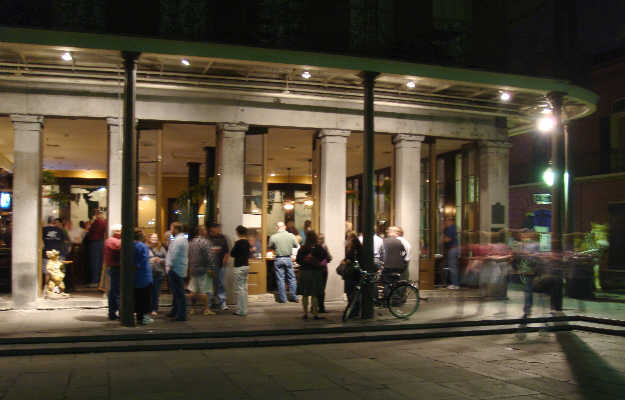
[page 14]
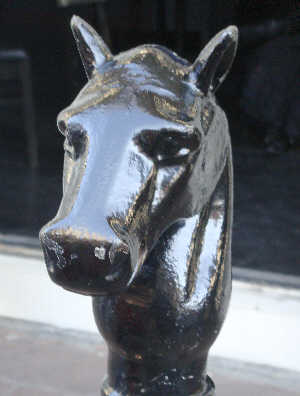
There is a silence of peace when the tribes are reconciled,
when the cool evening falls. . . .
There is a midday silence,
when the sun suspends all thought and movement.
There is a false silence, when the north wind has died
and insects, torn like pollen from the interior oases,
arrive to announce the sandstorms from the east.
There is a silence of intrigue,
when one learns that a faraway tribe is plotting something.
There is a silence of mystery,
when the Arabs discuss their incomprehensible differences
among themselves.
There is a tense silence when a messenger
is late returning.
A sharp silence when, at night,
one holds one's breath to listen better.
A melancholy silence,
when one remembers those one loves.Saint-Exupéry needed the desert at this point in his life, and came later in life to understand how valuable it was to him as a young man.
[page 14] The isolation, the abnegation, the single-mindedness of Juby were a tonic to a young man undisciplined, a little frivolous, in great need of being needed. "Anyone who has known Saharan life, where everything appears to be solitude and nakedness, mourns those years as the most beautiful he has lived," he wrote two years before his death.
Saint-Exupéry loved to have books around him, whether he read them or not. I often tell friends when they ask why I have so many books, "I buy more books in a month than I can read in a month, and plan to stay alive to read all of them." Whenever it occurs to me to get a private office somewhere where I could write in peace without the maid or the lawn crew with their loud and noisome equipment hovering about me, I am stopped at the thought of leaving my books behind me in another location. No Google search can beat a quick walk down the hallway to my library for the exact reference while I am in the act of writing.

We shared another habit, that of reading and writing while piloting a craft. His was an aircraft, mine a ground craft. Reading while driving on an American interstate highway outside of downtown traffic is almost too easy; I once had to negotiate 10 miles of s-shaped curves on the River Road of the Mississippi River every day for 7 years and taught myself to read while driving this stretch of road because it was valuable and dependable reading time while I drove alone to and from a job that was much less pleasant to me than reading.
Saint-Exupéry lived in a world of his own and soon even his fiancé Louise understood what that meant, when in a letter to his mother, talking about how she and Tonio lived in a dreamworld of their own, or dreamworlds of their own, she wrote, "He describes for me terrifying or sublime moments spent between the sky and the earth, and I, who can think only of furnishing our future home, interrupt him to ask if he likes well-padded chairs." Apparently he never told her about his dream home in Cape Juby with the crates for a bed.
With the popularity of Aéropostale logos on teenagers' clothes today, one wonders if any of the wearers realize that the knowledge of the glory days of the airmail company owes its existence to one curious pilot who happened to be a writer and memorialized those times.
In his first crash Saint-Exupéry was napping while flying with Riguelle and the plane lost a connecting rod and plowed into the sand dunes of the Sahara at seventy miles an hour. When Guillaumet showed up to rescue them, it was decided that Saint-Exupéry remain behind to be picked up later. It was Saint-Exupéry's introduction to the desert, one that would inform his writings so many ways thereafter.
Saint-Exupéry filled a plethora of roles in his lifetime. During his stay at Cape Juby, there was a "long catalogue of herculean tasks accomplished by this ace, this soldier, this paladin, this adventurer, this knight-errant, this broad-shouldered tendre, the most taciturn man in the company but also its enfant terrible."(Page 158) Plus, as Beucler said, "He seemed to hold a degree in all subjects." (Page 162) A taciturn man, except in the middle of the night when he loved to make phone calls to friends. He once observed to a friend that "married friends were soon lost to him — this probably because they were less easy to coax from bed for a 3:00 a.m. literary discussion." (Page 167)
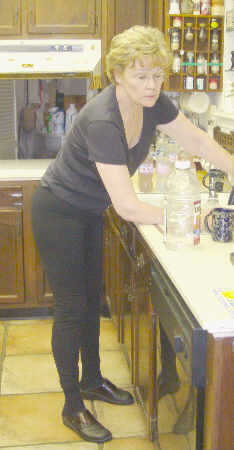
In a time when airplane travel was so novel, there were few people who could claim to be writing a sentence on one continent and finishing it on another, except Saint-Exupéry, who often wrote while he was in the air going from Europe to Africa to South America. His hearth existed on all three continents.
This reminds of me a Sunday night when I received a phone call at home from a Louisiana State policeman. He explained he was calling in response to a report that I had been seen reading the newspaper while driving to work. He asked me if I did that. I said that I did, omitting the many times I also wrote while driving, and asked him, "Is it illegal to read while driving?" He said, "No." That was it. I make a point of putting any reading material down out-of-sight when a police car passes me, but keep reading mostly when strangers or close friends were driving by during my hour-long commute to a nuclear power plant, what my wife and I called "nuclear prison", where I worked behind high fences with razor-wire on the top often for seven days a week, twelve hours a day, for many years. The reading material I consumed while driving helped keep me sane in an often un-sane work environment with too long hours and often too little work.
One can suspect that in the mansion described in this poignant passage below that Saint-Exupéry got the idea to call his great philosophical tome, Citadelle, whose English title is better known as Wisdom of the Sands. One only has to read the tremendous metaphor in Citadelle of those who tore down the great mansion of their father only later to walk upon its remains and lament how once "every footstep was full of meaning."
[page 180] A crumbling, once-luxurious 1886 citadel, this run-down mansion with its caved-in floors, its decaying lintels, had more charm for Saint-Exupéry than all of the steel girders of Buenos Aires. In his eyes it was not dilapidated but "a friend of time."
Saint-Exupéry wrote of the adventures and misadventures of his fellow mail pilots who flew in hazardous conditions at the controls of planes that could not overtop the mountains, so the pilots had to weave up and down and around the frozen peaks to survive the passes through the snow-capped Andes.
When he proposed to Consuelo, he did so in a way which would be unique to a writer: his proposal was by presupposition at the end of a manuscript of a book that he handed her to read. My wife Del would understand that form of a proposal as she reads and copy-edits my writings regularly. Consuelo was a "spinner of tales" and someone who would certainly pass the "Little Prince" test with flying colors, i.e., she would "see in a drawing of a hat a boa constrictor digesting an elephant."
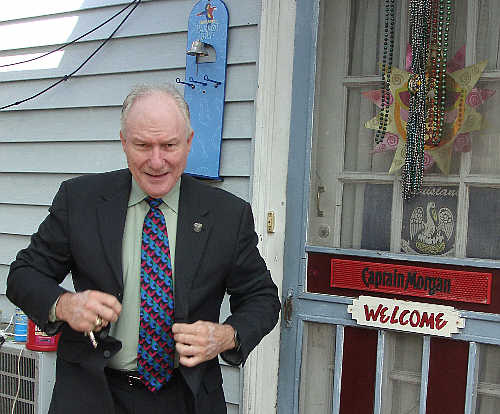 She was a writer in her own right and Saint-Exupéry respected her for that. As a writer, he was having trouble being both an aviator and a writer. The French were not given to respect someone who was a writer but also a tradesman. Americans had no problem with that, as critic Louis Kronenberger noted, "For the first time the airplane achieves at least a nodding acquaintance with art." He saw glimpses of the artistry of Saint-Exupéry and acknowledged it in the prestigious New York Times Book Review. In Saint-Exupéry's home country it was a mixed-bag in a country which didn't like mixed-bags.
She was a writer in her own right and Saint-Exupéry respected her for that. As a writer, he was having trouble being both an aviator and a writer. The French were not given to respect someone who was a writer but also a tradesman. Americans had no problem with that, as critic Louis Kronenberger noted, "For the first time the airplane achieves at least a nodding acquaintance with art." He saw glimpses of the artistry of Saint-Exupéry and acknowledged it in the prestigious New York Times Book Review. In Saint-Exupéry's home country it was a mixed-bag in a country which didn't like mixed-bags.While working in a nuclear power plant and writing on my own time, someone got hold of a collection of my short stories and printed copies on the local copy machines to hand out, all without my permission, and I found myself having to explain how these copies came to be. I knew it was time to become a fully-fledged writer and fly from the comfortable nest of a full-time job where I was not writing. I lived daily among people who seemed to be on Earth merely to say, "Here!" I felt like Saint-Exupéry when he wrote to a friend in Paris of the endlessness of an evening at the Hotel de France in Perpignan:
[page 224, 225] "The laughter and snatches of conversation that make their way to my corner are a torture. These people seem to be simmering quietly away — like a stew pot — to the end of their days. What point is there to their lives?"
"What point is there to flying?" a non-aviator might ask. To Saint-Exupéry, flying was the inspiration for his writing, flying, crashing into water or the desert, living in the desert or in dumb locations between flights. All this was grist for the mill. He even wrote an "elegy to an airplane engine" in his Wind, Sand, and Stars.
In Wind, Sand and Stars, three Moors from the Sahara are taken to the Alps and they stand transfixed by the immense flood of water cascading down and refuse to move. When asked why they wouldn't leave, they explained that they were waiting for the water to be shut off. Schiff doesn't mention that aspect of the trip, but she adds an epilogue to the tale, lines by Saint-Exupéry which did not make it into the novel, about how the Moors felt when they returned to their home, "The Sahara seems to them emptier, the game of war more illusory. For the first time they realize the Sahara is a desert."
The inspiration for Saint-Exupéry's most famous novel likely came from this scene as he narrated over the phone an article for the next morning's Paris-Soir edition. Hervé Mille, sat by her side as the secretary, Madame La Rosa, typed the words as Saint-Exupéry read the story. It was a story of a "cherubic blond child sleeping soundly between his parents" on a train carrying Polish workmen expelled from a xenophobic France in 1935. That cherubic blond child would later come awake as the hero of The Little Prince.
Saint-Exupéry flew in airplanes such as the Simoun in which there were no radios, and he flew in areas such as along the South American coast which had few navigational radio broadcasts. The radio was of little more use than to send out a Mayday call or get a weather report from the tower at an upcoming landing site. He was enthralled by the American system of aviation more than by the skyscrapers or frenzied life style of New York City.
When Consuelo's father offered Saint-Exupéry coffee plantations in El Salvador if he would settle there with his wife, he demurred, "My dear father-in-law, my dear mother-in-law, it is too late for me to cultivate coffee beans. My job is to till the clouds." And so he would continue plowing through the air and the clouds till he finally plummeted into the sea.
At one point, biographer Schiff claims that Saint-Exupéry's book Wisdom of the Sands is "bloated by parable" as if its marvelous parables were excess baggage which could be thrown out the cargo bay to help the book fly better. In my opinion, the book was enriched by those parables, comprising as they do the heart and soul of the book, without which the book would shrivel up like an autumn leaf and flutter helplessly to the ground.
One short passage shows that Saint-Exupéry had a food dislike for carrots, obviously a doylic memory of sadness, a bodily state stored before he was five years old. The nurse kept putting the carrots on his plate thinking he didn't like to eat them, and said in exasperation, "But he doesn't have to eat them." This caused Saint-Exupéry to explode, "Of course I don't have to eat them. It's the sight of them I can't stand; they make me sad!"
Convalescing in a Canadian hospital, he wrote to his friend Natalie, "Odd planet, odd problems, odd language. Maybe there is a star where life is simple." After years of drawing the blond-hair little boy, thoughts about different planets and different stars, taming people, thoughts on what is essential, thoughts on the meaning of things, the Little Prince began to emerge in book form in 1942.
What meaning for the Fox's Secret have I evolved over the thirty-plus years that I held it as an unanswered question? My current thought is that "what is essential is the meaning of things" and it is meaning which is often invisible to the eye, but the heart knows it. Such as Silva's heart knew of the pain she felt when Saint-Exupéry was late as he was so frequently. His tardiness likely led directly to the Fox's Secret thanks to Silvia.
Below is an image from the Fiftieth Anniversary Boxed Edition of The Little Prince which was drawn by Saint-Exupéry in the second half of 1942 with the children's watercolor set he bought in New York City at an Eighth Avenue drugstore. This is probably very close to the figure which appeared to Saint-Exupéry one day and announced himself. If you look intently, the Little Prince may speak to you.
[page 384] When the writer was asked later how the child-hero had entered his life, he said he had looked down on what he had thought was a blank sheet of paper to find a tiny figure. "I asked him who he was," he explained. "I'm the little Prince," came the reply. How much did Saint-Exupéry resemble his hero? "You are an extraterrestrial," Aglion informed him one day, before he had yet read the book. "Yes, yes, it is true, I sometimes go for walks among the stars," admitted Saint-Exupéry, who made several sketches of the aviator-narrator but chose not to include any of them in the text. (He is as much that narrator — who has "lived his life alone, without anyone that I could really talk to" — as the Prince, who cries, "Be my friends, I am all alone" from a desolate mountaintop, to hear only his own echo.)
I must admit to being one of Saint-Exupéry's ardent admirers and his Wisdom of the Sands (Citadelle) was the opposite of soporific as Schiff pegged it, hitting me with the force of a magnitude 6.5 earthquake. It strikes me as an unanswered question why Stacy Schiff could devote so much work to the biography of a man and find his greatest work to be abstruse and sleep-inducing. For now, I will assume some lack of understanding of the deep meanings and of the healing quality of the parables which she claims "bloat" and "bulk up" the volume.

Saint-Exupéry was not a fan of General de Gaulle, and never met him. The "man de Gaulle" wanted to meet Saint-Exupéry, but the "General de Gaulle" would not allow him to. (Page 446)
In closing, I have assembled some notable quotes from the biography which didn't seem to fit anywhere else and which stand on their own merit.
[page 330] "When the flight is normal Saint-Exupéry is dangerous; given complications he's brilliant." [Henri Alias's summation of Saint-Exupéry's flying career.]
[page 345] "You never have to wonder what his point is: it explodes." [Otis Ferguson, an admirer of Saint-Exupéry's timing.]
[page 388] As Maurois said of him, "Either he dominated the conversation or he dreamed of another planet."
When Saint-Exupéry wrote to his friend calling her "Little Silvia", he was seeing rightly through his heart the little girl which lives within the grown woman for whom he felt such tenderness and friendship. In the Velveteen Rabbit, Toby's grandmother sees life through her eyes looking at her social circle and obligations, her son John sees life looking through his eyes at the balance sheets of his business, and it takes a little boy, Toby, to help them each re-capture the little girl and little boy within them and to look upon the world through their hearts once again. Saint-Exupéry gives every reader of his books, especially The Little Prince, a chance to become little again and to understand the Fox's Secret: "it is only with the heart one can see rightly what is essential is invisible to the eye." One can never look into a starlit night sky after reading about the little Prince without seeing with one's heart that the stars are laughing in delight.
AFTERWORD

Some fifty-four years after Saint-Exupéry went down into the sea in his Lockheed P-38, his silver bracelet with his name inscribed on it was recovered from the sea and an expedition found remnants of his plane. The half-century mystery was over; his body was given up to the sea as the fortune teller predicted, but his spirit yet is tilling the clouds over head wherever and whenever you are reading these words. Here's a brief quotation from Schiff's Afterword:
[page 449] On September 7, 1998, a fisherman trawling off the coast of Marseilles plucked a silver identity bracelet from his net. It was pitted and blackened, but a swipe of the thumb revealed the words, "Antoine" and "Saint-Exupéry." With further scrubbing the New York address of Reynal and Hitchcock emerged, along with Consuelo's name. "The ocean is so vast, and a bracelet so small," exulted the fisherman. "It's a miracle."
Consuelo was arguably a fortune teller in her own right because she wrote him when he was planning a flight from France to Saigon.
[page 451] In 1936 she pleaded with him: "Promise me, Tonio, that you won't fly over water or even anything that looks like water. It's silly of me to bother you with my superstitions, but I don't believe water likes you."

This is a poem dedicated to Antoine de Saint-Exupéry who disdained plowing ground for coffee plants to "till the clouds."
Till the Clouds
Till the clouds roll by
Antonio must fly.
Till the clouds roll by
Antonio must try
To till the clouds or die.Till the clouds roll by
Antonio must plowTill the clouds roll by
Antonio must plow
The fields of air and how.Till the clouds roll by
Antonio must still
Be tilling the clouds on high.Read the Review at:
http://www.doyletics.com/arj/saint-ex.htm2.) ARJ2: The Influence of the Dead on Destiny, GA#179 by Rudolf Steiner
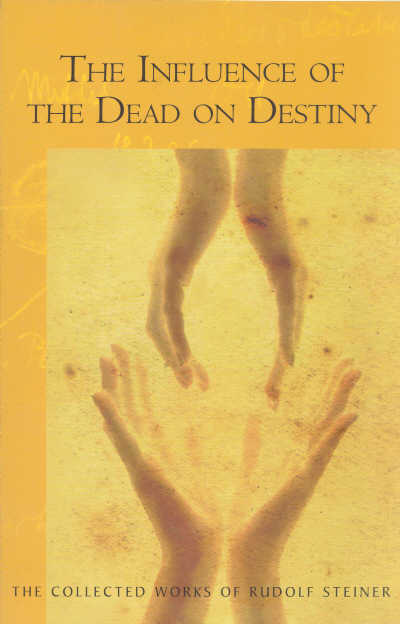
Where does the boundary between the physical and spiritual world lie? To listen to most folks, they consider "Heaven" as some distant place we go to after death, a place where Christ Jesus and God reside, as if it were a place like Washington, D. C. or Paris, France, where we must be transported to in order to arrive. It is easy to consider the boundary between where we are now and Washington or Paris, but where is the boundary between us and the spiritual world? Steiner tells us bluntly, "The boundary really lies right in the middle of the human being."
[page 1] Precisely this is important for understanding the world: the boundary between the physical world and the spiritual world is found within the human being. I have often pointed out, from the view point of spiritual science, the great importance of natural-scientific methods of thinking both for the present and for the future; but this scientific thought really stands more or less where it has always stood from its beginnings. You could well say that it is actually suited for spreading darkness over certain important truths of life.
As student of physics, I was immersed for decades in scientific thought, and it chagrins me to find that I was involved in the process of spreading a blackberry jelly over the white bread of truth and then proudly proclaiming that the truth I have covered up doesn't exist because I cannot see it! This is a silly metaphor, but if you will read how natural scientific thought has covered up the existence of the spiritual world by dividing our perceptive capabilities into sensory and motor neurons, suddenly you may recover the truth lying under the "darkness spread" we have covered it with.
In Oliver Sacks' book, "A Leg to Stand On", we have a first-hand report by neurologist Sacks about his mountain-climbing accident in which he nearly lost a leg. He makes it perfectly clear that during the time he was hospitalized that he could not perceive the existence of his leg which lay motionless on the bed still connected to him. He didn't even believe it was his leg. Clearly no perceptions of his leg were being transmitted to him, and without those perceptions, his will was unable to move the leg. Yet, the surgeons and neurophysiologists attending him claimed it was the lack of motor neurons which kept him from moving his leg. This claim about so-called motor neurons is what Steiner calls the darkness spread over the truth above.
Another example which may help you to understand how important perception is to moving one's limbs. In this example, you will have to agree that one is just barely able to perceive one's leg and just barely able to move it, but yet the motor nerves are present and functioning. The example I'm thinking of is when one's leg goes to sleep (becomes numb from sitting on it perhaps). Slowly as one recovers the normal feeling in one's leg, one recovers the ability to move it normally. The importance of this observation is that it shows that ability to move recovers in complete synchrony with the ability to perceive the impaired limb.

These two examples show the difficulty that neurophysiologists have in understanding the boundary between the physical and the spiritual world: they cover it up with an arbitrary distinction by postulating the existence of sensory and motor neurons. If that distinction is appropriate, those who hold to it should be able to provide an example which motor neurons can be fired off to move a limb for which no sensory neurons are providing evidence of its existence. They simply say, "Sacks can't move his leg because the motor neurons are injured." They make a distinction where none exists and never have to prove it — that is an effective way of spreading darkness over the truth.
In the middle of the human being is the will through which we make decisions to move our limbs. Our will exists as a spiritual entity of which we are not aware, but through which we move about in the world. When the sensory information arrives of the existence of a leg, our will can cause it to move and receive sensory information about its movement.
Our will lies at the boundary between the spiritual world and physical world and in the middle of the human being. When one understands this, the need for the arbitrary distinction of sensory and motor neurons disappears, and "one sees rightly what is essential is invisible to the eye" as the Fox explained to the Little Prince.Natural scientists since the fifteenth century have mostly stumbled around in a world in which they strive to explain the visible world without a need for postulating an invisible or spiritual world. When they reached, in the past hundred years, the realm of quantum physics, suddenly their explanations no longer made sense. Physicists had discovered the boundary of the spiritual and physical world in their examinations of the microscopic world of quantum effects with their macroscopic measuring equipment.
The following poem ties together the human will and quantum particle which both provide insolvable conundrums for natural scientists, up until now.
In the heart
of the human being
lies the boundary
between the physical
and the spiritual world.In the heart
of quantum mechanics
lies the boundary
between the physical
and the spiritual world.Quantum particles
sit on the fence
between the physical
and the spiritual world
like Mugwumps —
their mugs on one side
their wumps on the other
till like Humpty-Dumpty
they have a great fall
and are observed by yours truly
on the physical side of the fence.Then all the king's horses
and all the king's men
cannot put Humpty-Dumpty
together again.The pieces which fall
on the spiritual side of the fence
may be observed by others
at the far end of the universe.I do not pretend to understand fully this mystery of will, quantum particles, the physical world, and spiritual world, but there is a relationship which is not one of here and there, where Earth is here and Heaven is there — someplace else. It is all here and all interwoven, in our nerves, and in the quantum particles which make up our nerves and tissue.
One would do well to study what Steiner says about the difference between ideas and reality. He presages what Alfred Korzybski later said about maps and the territory, "The map is not the territory; it cannot represent all of the territory." Thus, anyone who deals in maps or ideas must necessarily be limited to a one-sided view of a multi-ordinal reality.
Before I began studying Rudolf Steiner, I was unaware of my feelings — I felt things, but never considered those feelings to be important or worthy of talking or writing about. To me as a physicist, only thoughts and ideas were worthy of discussion, not feelings. I recall reading James Boyd White's book, When Words Lose Their Meanings, and discovering that meaning amounted to a lot more than thoughts and ideas, meaning also included feelings. In the Index of that book, there are several dozen references to Emma, a novel by Jane Austen. Since I had never read Jane Austen's works before, I bought a copy of this novel and was amazed to find the author writing about people's feelings in a way that I might have written about ideas or thoughts. It was my first awareness of feelings and yet that awareness still existed as a thought or idea. Several years later I began studying Rudolf Steiner's works and came to understand that feelings are a conduit through which spiritual realities come to us, even to those who have no other direct perceptions of the spiritual world, which includes most people in the world today. We are conscious of our feelings, but not of their deeper meaning as part of our reality.
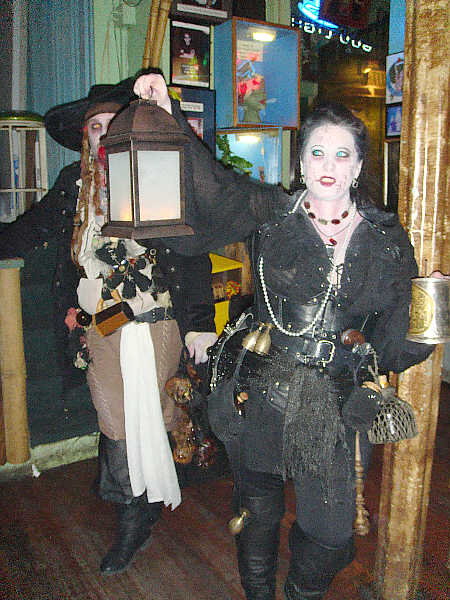
Have you ever heard anyone say, "If you shiver, that means someone is walking on your grave?" Or it means that a ghost is trying to get your attention? In a recent movie "Ghost Town" whenever the living spirit of a dead person (a "ghost") walked through a person, or vice versa, the person sneezed. Another movie, "In the Electric Mist", portrayed a Confederate army camp, and a general who appeared to Dave Robichaux and advised him throughout the movie. Other movies comes to mind, such a "Ghost", "Milagro Beanfield", and "Ironweed" in which ghosts make their presence known to characters in the movie by various means, but only we as viewers of the movie can witness them. In the movie "Dedication" the ghost of his illustrator returns to a writer of children's books, and as soon as the writer is ready for a real relationship with a woman, the ghost jumps out of sight to allow the writer to finish alone. We as audience are in effect given clairvoyant vision of the full spiritual reality while the characters of each film are limited mostly to feeling and will.Often the lead characters are called schizophrenic or crazy because they are reacting to a reality that other characters do not share.
Most of the world we experience does not exist for the spirits who live in our world. We can experience with our sensory perceptions the lowest level of the physical world of minerals and plants up to all the higher animals and humans and the impulses within them. For the spirits, all the mineral-based materials and life-forms extending into most plant life are invisible, and the lowest level they can experience comprise the impulses or forces living in animals and humans. The living spirits we mistakenly call the "dead" live in a world where everything they do causes pain or joy. They operate on feelings the way we operate on minerals and things. For example, in this world we break a rock or hammer a nail into a tree without thinking about any pain the rock or tree might feel.
[page 26] If we knock on a table, we feel that it does not cause the table pain. The dead can never carry out an action without knowing that they live and weave not only in a living element, but also in a living element filled with feeling. The feeling-filled stimulus is spread out over their entire environment.
We will pick a bouquet of roses from our garden without once considering the feelings of the roses. With animals, we are more considerate, as Steiner humorously points out in this next passage:
[page 26] Even among Anthroposophists I have found that not everyone always prefers to leave roses on the bush, although the feeling has already progressed so far that no one has ever presented me with a bouquet of nightingale heads at a gathering! Here we begin to feel how the life that expands within us continues on into our surrounding world.
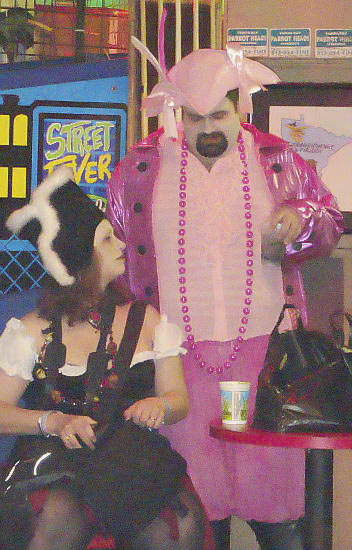
The living spirits (the so-called dead) have access to information that we living in the flesh do not. Steiner says that "learn to know this world from all sides through having to penetrate step-by-step all the secrets that here on Earth are concealed from them". This should bring up the question in every thinking person, "Why?" Why are these things and processes kept secret from us? Why is there a curtain thrown over our ability to access this knowledge and these abilities while we live in the flesh? As you can imagine the answer to this question has been known, but kept secret over the ages, primarily for the protection of humanity from itself until the time was ripe for them to possess the knowledge and have the abilities.
The reverence for all things living wanes as humans develop free will (as when they grow up from infancy) and waxes when they have transited into the spirit world again. What the child, newly arrived from the spirit world, must unlearn, the dead, newly arrived in the spirit world, must re-learn, and that is "reverence for everything living".
It was not in my consciousness when I wrote my essay, Art is the Process of Destruction, that any work of art involves destruction of some living thing. My focus was on the destruction of the sameness which exists at the time when a new form of art comes into existence, and how this newness represents an input from the spiritual world. But Steiner makes it clear that any art work, any artificial representation by a human being, involves the destruction of some living materials in the process of its creation, so we can see that art is the process of destruction at an even deeper level than I had envisioned in my original essay.
[page 29, 30] Even when we create a work of art we must take part in the world of destruction. What we thus create first arises out of destruction. A beneficent world wisdom has only caused us at first to shrink back, as human beings, from placing what lives — from the animal world upward — at the service of mechanical art. In a certain higher sense, however, everything lives in the world. You will already realize this from the various accounts given over the years. But what do we actually do when we place what we perceive through our senses and combine through our intellect at the service of mechanical art? We continually carry death into life. Even a Raphael painting cannot come into being unless death is carried into life. More was living before a Raphael painting arose than after it came into being. In the universe this is compensated only through the fact that souls come who enjoy the Raphael painting and receive from it an impulse, an impression.
We meet a new person and something in that person enlivens us, some soul condition in that person makes us feel more alive — this is something we have all felt during our lifetime. But there are times when we feel this way and there is no new person around us to whom we can point as the source of this feeling. What do we do in those cases? We will attribute our good feeling to the weather or some external condition.
 What if that feeling came from a living soul which is not present in a body, but is hovering around us? How would that soul feel if its salubrious presence were attributed to the weather? Not all souls enliven us; some may weaken us, but the important thing is to notice these effects when they occur out of the blue, and not remain as if asleep to their presence. In the movies I cited above, the presence of the souls to humans in the flesh came about only under extreme conditions, as though these humans had to subjected to extreme conditions in order to receive the guidance that they would have otherwise continued to ignore from souls trying to help them.
What if that feeling came from a living soul which is not present in a body, but is hovering around us? How would that soul feel if its salubrious presence were attributed to the weather? Not all souls enliven us; some may weaken us, but the important thing is to notice these effects when they occur out of the blue, and not remain as if asleep to their presence. In the movies I cited above, the presence of the souls to humans in the flesh came about only under extreme conditions, as though these humans had to subjected to extreme conditions in order to receive the guidance that they would have otherwise continued to ignore from souls trying to help them.Here's a specific example of an impulse of feeling and will which weaves into a person's destiny. This kind of thing happens to us all the time, but only in such salient events as these do we become aware of it.
[page 35] Someone has the habit of taking a daily walk; it leads him onto a mountain slope. He goes there every day — it is his special pleasure. One day he goes there again as usual. Suddenly, while he is walking, he hears something like a voice (although it is not a physical voice) that says to him: Why are you walking along this path? Can you really not do without this pleasure? He hesitates and turns aside, to think over what has just happened to him. In this instant a piece of rock rolls down that would have struck him had he not turned aside.
Everyone reading the above true story will be aware of the impulse which lead the man to hesitate and may think, "Oh, that could have come from a living spirit." But did you notice that the "special pleasure" could also be an impulse from a living spirit? You can learn to become sensitive to these impulses, both the salient ones and the subtle ones, both the ones which happen and the ones which do not happen, as shaping your destiny.
This is a fishing metaphor, as anyone who has gone fishing will attest. There are fish underwater, but unless one of them swims close enough to the surface of the water to cause waves to appear, we are not sure there is a fish. These events such as the questioning voice causing the man to pause and miss the falling rock was like a wave breaking through the surface of consciousness.
One does not need clairvoyance in order to develop a consciousness of our belonging together with the living spirits, the "souls of the dead" which surround us. They are ever present, both in our sleeping at night and in our awaking life during the day. Steiner considers it his task and that of his spiritual science to help all humans develop an awareness of their presence.
How can we relate to the so-called dead, those living spirits of our dearly departed which live among us? We can read to them. They will especially be able to benefit from the thoughts of spiritual science. The process called "reading to the dead" is simplicity in itself: One holds an image of the person in mind and reads. No special training is required, no clairvoyant powers, just the intention to do and the action of thinking of them as you read.
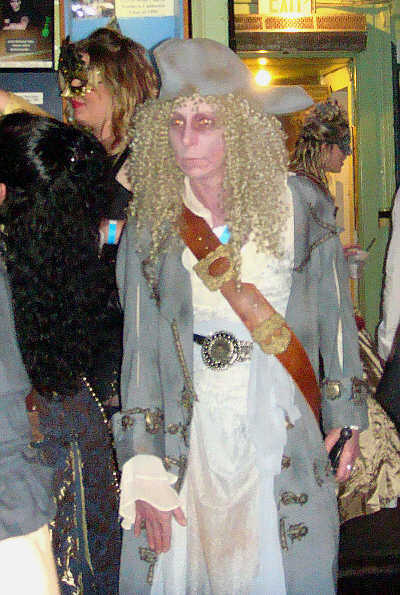 There is a curious inversion which goes on when communicate with the dead: what you hear yourself saying is actually coming from the living spirit of the dead person, and what you hear them saying in reply is coming out of yourself. Exactly how this works is a puzzle to me, but somehow it feels right. I expect this will require a lot of meditation in order to make sense from it. An example of someone learning from the dead is portrayed in the recent movie, "In the Electric Mist". A Confederate General appears to and speaks wise words to Dave Robichaux. We can understand that the words which the General spoke to Robichaux arose from Robichaux's own soul.
There is a curious inversion which goes on when communicate with the dead: what you hear yourself saying is actually coming from the living spirit of the dead person, and what you hear them saying in reply is coming out of yourself. Exactly how this works is a puzzle to me, but somehow it feels right. I expect this will require a lot of meditation in order to make sense from it. An example of someone learning from the dead is portrayed in the recent movie, "In the Electric Mist". A Confederate General appears to and speaks wise words to Dave Robichaux. We can understand that the words which the General spoke to Robichaux arose from Robichaux's own soul.The number 25,920 is a number which lies at the base of our human existence, what Steiner calls our threefold breathing. To understand how it works, calculate the number of breaths a human does in an average day at 18 a minute (18 x 60 x 24). This is our basic breathing, that of air which goes in and out our lungs. There is a larger rhythm of breathing in which our astral body and "I" goes out of our body when we sleep and into our body each day as we awake. If take 71 as the average lifetime and multiply that by 365 (our daily breaths of astral and "I"), we get (365 x 71) or 25, 915. If we treat our lifetime as a cosmic day and multiply it by 375, we again get 25,915 years which the Great Year during which the Sun returns to its position in the background of the constellations of the sky. Our air breath, our astral breath, and our lifetime breath are all three related to great breath of the Sun of 25,915 years.
Physicists who try to comprehend quantum effects in terms of the physical world get a little dizzy because they lack a physical interpretation for such effects as the collapse of a wave function in one edge of the universe affecting quantum objects in the other edge of the universe. Their reaction is similar to the way people feel when they try to imagine the spiritual using their spatial concepts learned from physicists. Allow yourself to stretch your concepts of space and time and imagine yourself in the spiritual world in which you exist outside the universe looking into our cosmos as if you were a fortune teller looking into a crystal ball. The planets act like vowels and the zodiacal constellations act like consonants through which the spiritual explorer reads the text of the cosmos at any moment.
The type of reading Steiner describes which is done by our spiritual explorer is a type I have seen in several movies; one was "A Beautiful Mind" where letters lighting up in random pieces of text arrange themselves to form words and meaning in John Nash's mind.
Cause and effect — where would our natural science be without cause and effect? We take it for granted that every effect has a cause in our world. But our world is a world in which our perceptions provide us a mirror image reflection of the real world and when we observe, for example, a fight between three people, A, B, and C, reflected in a mirror, we can believe there are people in the mirror fighting as the mirror is only reflecting what is happening outside the mirror.
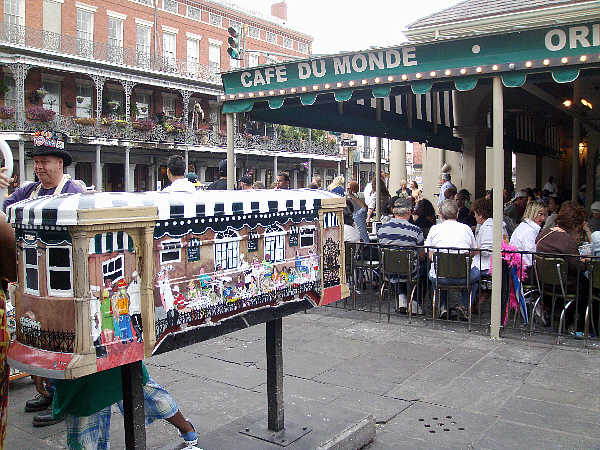 Rightly understood, all cause and effect in our physical world is like images in the mirror interacting — the real cause lies in the spiritual world, not in the maya of the reflected world we perceive with our sensory apparatus. We are like the men in Plato's Cave arguing about which shadow caused the other to move and why. The convenient fable we call history is exactly such an exercise in futility which it ascribes causes and effects.
Rightly understood, all cause and effect in our physical world is like images in the mirror interacting — the real cause lies in the spiritual world, not in the maya of the reflected world we perceive with our sensory apparatus. We are like the men in Plato's Cave arguing about which shadow caused the other to move and why. The convenient fable we call history is exactly such an exercise in futility which it ascribes causes and effects.The last subject Steiner takes up in Lecture 4 is that of freedom. Freedom comes from pure thoughts, direct inputs from the spiritual world — not from the passions, desires, and instincts which drive us and from which only unfree deeds can result. These drives arise from the maya of the world around us and do rise to the full capability of the human being which is to act in freedom out of pure thoughts. Pure thoughts could be taken to mean morally clean thoughts or thoughts arising from the spiritual world directly, but deeper consideration would show that these two meanings name a distinction which in fact does not exist.
A moral imagination is the opposite of the mirrored reflections sent us by physical reality, and is composed of real impulses of Imagination, Inspiration, and Intuition. If we cannot, as most people today, perceive the moral imagination directly, it appears to us as mere fantasy. It should be clear to the right thinking person that one does not need to be clairvoyant to attain moral imagination, but certainly if one is clairvoyant, one comes to it consciously. But that has not stopped humans from achieving great things through moral imagination which is the mainspring of human progress because it is a fountain from which springs all that is new in the way of ideas, inventions, and art.
One of the beautiful results of the old conundrum about which came first the chicken or the egg is that it reveals the limited nature of our concepts of cause and effect. The chicken cannot be both the cause of the egg and the effect of the egg, and yet the reality of the situation requires it to be so. Whenever our natural science would like to elevate cause-effect to the throne of a scientific law, there is the court jester chicken-egg blocking the way.
[page 77] The materialistic conception would actually like to eliminate the concept of free will. It would also like to interpret the events taking place in the course of history in the same way that it contemplates scientific matters: namely, that a preceding cause always produces, with a certain necessity, something that follows it as an effect.
 This next topic is one that I have pondered a lot. It has to do with the one million salmon eggs which are laid by a female salmon to produce only a few salmon — what a shame to have all those eggs die without becoming a salmon. One can extend this thought to the wheat we grind into flour which will never produce another wheat plant, etc. Here is a cause, a wheat seed, which will never produce an effect, a wheat plant. Steiner explains it simply: some causes do not produce effects, at the least they do not produce the lived-out-completely effects we would expect from them, like the unfertilized salmon eggs.
This next topic is one that I have pondered a lot. It has to do with the one million salmon eggs which are laid by a female salmon to produce only a few salmon — what a shame to have all those eggs die without becoming a salmon. One can extend this thought to the wheat we grind into flour which will never produce another wheat plant, etc. Here is a cause, a wheat seed, which will never produce an effect, a wheat plant. Steiner explains it simply: some causes do not produce effects, at the least they do not produce the lived-out-completely effects we would expect from them, like the unfertilized salmon eggs.[page 78] Every year a great number of life germs develop in the ocean-seeds or embryos that do not become living beings. The life germs, or eggs, are laid and most of them perish. Only a small part of these grow into real living beings. This, of course, does not only happen in the wide ocean but also in the whole of nature. Consider how many life germs are supposed to become living beings, even in the short space of one year! How much is meant to become alive and does not attain life, when eggs are laid that do not develop! We could say that all these germs of life contain causes that do not produce effects. Indeed, anyone who considers nature in an unprejudiced way — will find that there are countless things in nature that must be designated as causes, although they do not produce the same effects as when the causes live themselves out completely. There are countless instances where life is interrupted, so to speak, and does not attain its goal.
What do spiritual investigators see when the eye of their soul sees such repressed processes of life? (page 79) We see eggs and seeds which die, but if we could dream in a cosmic sense we would see these apparently dead life-germs contributing to the elemental or pre-life forms which fill the world around us. But we mostly dream egotistically in our day-time consciousness and this awareness escapes our notice, up until now.
[page 79] When we connect with our surroundings and at the same time develop the forces we develop in dreams, we experience imaginative thinking. We can experience consciously through imaginative thought what is kept back in the processes of nature and does not reach the stage of physical living beings. Beings arise from such repressed life germs that are only accessible to imaginative thought. We could dream of them if we dreamed as beings belonging to the hierarchy of the angeloi, instead of as human beings. In fact, if I may use this expression, the angeloi dream of the beings that are simply the products of the life germs that have only apparently perished, rising up every year in great numbers from the sea and the earth as elemental forms.
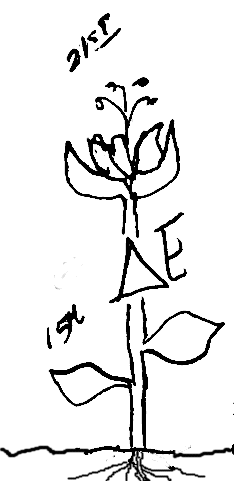
This insight provides us another example of something we have felt bad about based on our limited cause-effect reasoning which was an unnecessary waste of effort. Instead of feeling bad, we could with a cosmic-dreaming consciousness experience a spiritual fragrance arising around us in the elemental world. We would come to realize that when life-germs en masse are killed, the spiritual world receives a benefit it would have else not received. I just this moment squashed a female mosquito about to extract some blood from my arm in order for her to reproduce. By interrupting the life-germs of future mosquitos in her body, I have released them into the elemental world.
On pages 83 to 85, I wrote in the margins of the book this short poem:
Every birth is a wonder.
Every work of art is a wonder.
Every scientific discovery is a wonder.
Every poem is a wonder.
Every un-caused effect is a wonder.
Every act of free will is a wonder.In the full review I take the poem and explain its inspiration one line at a time.
Does nature ever take a leap forward? Given that human beings are hardly considered to be a part of nature in the twenty-first century, I doubt whether the leap forward that Steiner considers here would qualify in most naturalists's eyes. I drew on page 112 the figure below to represent the leap forward during the fifteenth century using my delta-E to represent an evolutionary jump in the evolution of consciousness. I'm reminded of a famous cartoon showing a scientist explaining a large set of calculations on a blackboard to a fellow scientist. He points to a gap in the equations and says, "And here, a miracle occurs." We could point to the fifteenth century and say that. My figure show that a miracle occurs in the life of the plant when suddenly the energy that went into making leaves is funneled into making a beautiful flower, a flower bearing seeds, without which the plant is doomed to die forever. It is only by such a metamorphosis that a plant can survive from one generation to the next.
One doesn't have to be reading Rudolf Steiner for very long before one encounters this criticism of him, stated in various ways, "He only rehashes an ancient gnosis." Steiner eschews any kind of rehashing, whether it be of the New Testament or of gnostic writings. In his Gospel Lectures, he read them only after he had familiarized himself with the events of Christ Jesus' time and there is definitely no "warming up" or rehashing of ancient writings in these amazing lectures. His Fifth Gospel reveals events in Christ Jesus's life which is not recorded anywhere. As for gnostic writings, Steiner has pointed out that the gnostic writings were destroyed in the early centuries of the Church replaced by gnostic writings composed by opponents of gnosticism. Any one who studies Steiner's body of work objectively will immediately notice that he does not base his writings or lectures on the work of other people, but his own research. When his writing on the evolution of the Cosmos in which we live matches up with ancient writings, it is because there is an objective spiritual world in which we live, which evolved in only one way, even though there may be many ways of describing that evolution. Steiner uses modern terms to replace sesquipedalian esoteric names of theosophy, but renaming for clarity does not equate to plagiaristic rehashing of the type he is often accused of by his virulent critics, both in his own time and now. His arguments which reveal the baseness and lack of understanding his contemporary critics reveals the similarity a century later to critics in the twenty-first century.
 One wonders at the fear which would entice them to attack a seeker of the truth — it can only be that the truth lies deep within them, and what they seek to hide they must advertize to all, which is the way of all psychological repressions. So they attack in Steiner what exists within themselves, but which they refuse to acknowledge, up until now.
One wonders at the fear which would entice them to attack a seeker of the truth — it can only be that the truth lies deep within them, and what they seek to hide they must advertize to all, which is the way of all psychological repressions. So they attack in Steiner what exists within themselves, but which they refuse to acknowledge, up until now.[page 112] Now, you must not misunderstand me. I cannot in any way, in accordance with all the requirements of anthroposophically oriented spiritual science, promote warming up old things. The talk of the need to rehash old books and old views, that is so prevalent in the world today, cannot be done in our arena of anthroposophical spiritual science, because we must obtain directly from spiritual life itself what must be revealed today, and because something significant is being revealed for those who receive it.
This is Steiner's view of our goal in the time between birth and death: Prepare for our time between death and a new birth. We in this life are not on board a cruise ship which is going to sink (as someone once said), but rather we are on board a university ship in which we learn the skills we will need in the new land to which we are immigrating, so that when we arrive we will be able to operate with the freedom we will have brought with us.
Read the Review at:
http://www.doyletics.com/arj/influenc.htm= == == == == == == == == == ==
I hear often from my Good Readers that they have bought books after reading my book reviews. Keep reading, folks! As I like to remind you, to obtain more information on what's in these books, buy and read the books — for less information, read the reviews.
== == == == == == == == == == == == == == == == == == == == ==
8. COMMENTARY:
= = = = = = = = = = = = = = = = = = = = = =In this section I like to comment on events in the world, in my life, and in my readings which have come up during the month. These are things I might have shared with you in person, if we had had the opportunity to converse during the month. If we did, then you may recognize my words. If I say some things here which upset you, rest assured that you may skip over these for the very reason that I would likely have not brought up the subject to spoil our time together in person.1. Padre Filius Reads a Bumper Sticker this Month:
Padre Filius, the cartoon character created by your intrepid editor and would-be cartoonist, will appear from time to time in this Section of the Digest to share us on some amusing or enlightening aspect of the world he observes during his peregrinations.

This month the good Padre sees a bumper sticker.
2.Comments from Readers:
- EMAIL from Henry in South Carolina:
Bobby
Although years ago I was on the Barfield List serve, some how it quit coming. For some time now I have been trying to get hooked up again. I have been following the instructions on davidlavery.net/Barfield/ Barfield_Resources/Listserv.html with no success.Since I know you were (are) a participant, perhaps you can help me. Are you regularly receiving their sends? Is it still working? Or is it shut down?
Henry[Unfortunately, I tried the List address I had, and it also didn't work. If anyone on the Barfield List reads this request for help or explanation of what has happened, please notify me. See my email address at http://www.doyletics.com/bobby.htm
Thanks!]- EMAIL from Theresa:
Well, I'm back safe and sound, a day older having celebrated a milestone birthday !!!, and must say to all of you, cruising the California Coast from San Francisco to Pebble Beach, back to Sonoma County, and Napa County for a week in an RV was an absolutely wonderful experience . . . one I would recommend to anyone! Returning to California — the state of my birthplace — was special for me also. I did my Italian heritage "proud" . . . Celebrated it in grand style. . . . Drank lots of Italian wine, and saw how olives and artichokes grow . . . visited olive press companies and tasted as many delicious olive oils as I did wines !!! Weather was perfect the entire trip (kind of like today's weather (Saturday, April 4) was in Baton Rouge). Actually our temperatures weren't always as warm as today, but very pleasant. Evenings were a little chilly, but very nice. Not a drop of rain, clear, blue skies the entire trip. We stayed at beautiful parks with lots of hiking, streams, and gorgeous beaches (Nothing like the Pacific Coast). I really enjoy hiking and I even walked across the entire Golden Gate bridge (as Kerry rested in the RV !!!) Hoping all of you are well. As the saying goes, it's nice to go, and nice to come back! HA HA Looking forwarding to talking to all of you soon.
Love, Theresa
- EMAIL from Patricia about discovering doyletics:
Hi, Bobby. What a fascinating theory! I've been treated for depression, anxiety, post-traumatic stress for years. I think I'll try this system and see how it goes.By the way, pleeeaaase tell me where you got that beautiful "golden leaves tree." I really would like to have one.
thanks. Patricia[NOTE: the one Patricia is looking for graces the top of this doyletics webpage. Anyone who knows where she might buy one of these golden leaves trees, please contact me here: http://www.doyletics.com/bobby.htm
- EMAIL from fellow pyrate Steve Sanders in "Port Worth":
Ahoy there, shipmate!
Just wanted to let you know that yours truly took the Grand Prize in the Poetry Division of Weatherford College's Canis Latran Writing Competition which is part of their "Books 'n' Authors 'n' All That Jazz" Festival which takes place each spring in Weatherford, Texas. In addition to an award and a cash prize, the piece I entered, entitled "The Regimental Ball," will be published in their literary magazine this year! Feels sorta good when someone who doesn't love you, know you or are related to you recognizes your work!
By the by, did you get a chance to read any of me stuff at PyrateCon? If so, how did it go over?
More to come!
Blackbead[Unfortunately I did not, but there's always Pyrate.con 2010 in which it can get done. Some people think the only thing that connects pyrates and poetry is the initial letter "p". Here's link to my review of Steve's fine book of pirate poems, Raising Black Flags.]
- EMAIL from Betty in Louisville, KY
Hello Bobby
I am jealous of your weather. We are still having too much cold weather to suit me. The flowers are gorgeous. Are they some you grow?
Your cabin also seems so neat and quaint in the woods. What a nice get away. I am still working every other week in TX, got part of my condo re-carpeted today with still more to do and not much other new news with me. Hugs,
Betty[NOTE: the photos in my Digest are identified if it's not from our gardens at Timberlane. Where possible I use the common name and/or botanical name.]
- EMAIL and photo from daughter-in-law Kathryn in Indiana:
Bobby,
Wow, I love the flower image at the beginning. [Peach Blossom at top of this Digest.] I bet you had fun in the French Quarter. I would love to be there with you. We're getting ready to go bird watching. We saw 15 blue herons yesterday, a few wild ducks and a bald eagle.
Love, KathrynONE: UNLOCK YOUR CAR REMOTELY:
About 1982 Del and I were visiting New York City and we locked our keys in the car which was parked on the corner of Fifth Avenue next to St. Patrick's Cathedral on Friday at rush hour. Definitely a worst case scenario. Perhaps you can remember one of your own. Now there's help with this technique using cell phones. The person who can unlock your car may be halfway around the world with your other set of keys! Requirements are the key has a remote opener as most cars do today ( and none did back in 1982 ). And both people have a cell phone. Here's the instructions. Del and I just tried the technique and it worked on our phones and cars. Be sure to place the car's remote directly next to the microphone opening of the cell phone.If you lock your keys In the car and the spare keys are at home, call someone at home on their cell phone from your cell phone. Hold your cell phone about a foot from your car door and have the person at your home press the unlock button, holding it near the mobile phone on their end. Your car will unlock. It saves someone from having to drive your keys to you. Distance is no object. You could be thousands of miles away, and if you can reach someone who has the other remote for your car, you can unlock the doors.TWO: DIRECTORY ASSISTANCE
Remember when you only had to dial O on your phoneset, and when the operator came on, you would say "Gambino's Bakery" and the operator would say, "I'll connect you."? That service is available everywhere in the country thanks to Google and there is no charge for the service. And it works exactly as the 1940s Operator did.
You simply dial 800-GOOG-411 (800-4664-411) and say "Gambino's Bakery, Gretna, Louisiana" and a voice says, "Top location is Lapalco, I'll connect you, or say More Information" and ZIP! you're talking to a clerk at the bakery or whatever. I used it to do exactly that, and faster than my fingers could do the walking, I had placed my order for a Chocolate Dorberge cake for Del's birthday on Easter Sunday. I've now used this service three or four times and it's worked every time. If you're driving into Peoria for the first time and need to meet someone in ten minutes for lunch and don't know where the restaurant is, say the restaurant's name, and when the maitre d. answers and leave your message about being a little late and ask how to get to the restaurant. Put this handy number in your cell phone today. Suggest you use: .411 for the Name as this will put it near the top of your contact list.
4. HOLLYWOOD JUSTIFIES SUICIDE AND MURDER It is a sad commentary on our time that two movie stars, Will Smith and Kristen Scott Thomas, are each made to suffer through a movie in which they must hold dour faces and hold secrets they cannot reveal until the end of the movie . In Will's case, in "Seven Pounds", the secret was his plan to commit suicide which the script attempts to justify by his organ donatiion scheme. In Kirsten's case, in "I've Loved You So Long", the secret was her killing her own pre-teen son whom she loved dearly, putting him to sleep by lethal injection as if he were a dog, to keep him from suffering pain, and spending 15 years in prison for her crime. Her statement reveals a lot, "The worst prison is the death of one's child — you never get out of it." It was a life-sentence in a prison she built for herself by killing her child, and one whose effects will extend well into her sojourn between death and a new birth.
These attempts to justify suicide and euthanasia remind me of two movies which speak to the other side of the story. "What Dreams May Come" shows the horrendous results of suicide upon the afterlife of a person who commits the act. "Lorenzo's Oil" shows the results of a mother and father who son is in constant, horrible pain, who struggle and succeed eventually in finding a cure for the disease which caused the pain.
Suicide and murder have no place in our society, and when Hollywood film makers make films which glorify these acts, treating them as justified under the right conditions, they enter the slippery slope which the world slid down in World War II. Certainly the people who blindly followed Hitler's Nazis thought they had the right conditions to justify murder and the Japanese kamikaze pilots the right conditions to justify suicide. It is my regret that I have to name these movies to warn you about them — we are all better off if they are ignored.

== == == == == == == == == == == == == == == == == == == == ==
9. CLOSING NOTES:
= = = = = = = = = = = = = = = = = = = = = =Thanks to all of you Good Readers for providing the Chemistry which has made this site a Glowing Success. — Especially those of you who have graciously allowed us to reprint your emails and show photos of you and by you on this website — you're looking good! As of June 1, 2019, it enters its 20th year of publication. The DIGESTWORLD Issues and the rest of the doyletics website pages have received over 21.6 MILLION VISITORS ! ! !
We have received over ONE MILLION VISITORS per Year to the Doyletics Website since its inception June 1, 2000, over twenty years ago. Almost 2 million in the past 12 months. We are currently averaging about 150,000 visitors a month. A Visitor is defined as a Reader who is new or returns after 20 minutes or more has passed. The average is about one visitor for every 10 Hits.
IMPORTANT NOTES about DIGESTWORLDtm Our DIGESTWORLD came into existence years before Facebook and all the other social media which interrupt people's schedules many times a day. All our photos, reviews, cartoons, stories, etc, come to you via a link inside of one short email Reminder at the beginning of each month. We hope you appreciate how we let YOU choose when to enjoy our DIGESTWORLD Issues. To Get a Monthly Reminder, Click Here .
We especially want to thank you, our Good Readers, in advance, for helping our readership to grow. NOTE our name is now: DIGESTWORLD. Continue to send comments to Bobby and please do create links to DIGESTWORLD issues and Reviews on LinkedIn, on your Facebook page, and on other Social Media. When you copy any portion of a webpage or review, please include this text: "Copyright 2018 by Bobby Matherne".
Email your friends about the reviews, the handy doyletics Speed Trace, the Household Hints, the cartoons, the Cajun jokes, the recipes, the poems, and the photos in all the DIGESTWORLD Issues archived on our website. Urge them to subscribe to the DIGESTWORLD Reminder so they won't miss a single issue!
The Subscription Process SIMPLE: no Reply Confirmation is required. An email to the Editor with your First and Last names is all that's required. There is never a charge for viewing any page on our website; nor for any of the guidance we offer to people using the FIRST AID KIT or asking for help with doyletics in any other areas.
For those who are able to contribute to the site we offer a year's subscription for receiving the DIGESTWORLD Monthly Reminders for $50.~~ NOTE: DIGESTWORLD is a Trademark of 21st Century Education, Inc. ~~ The cost of keeping this website on-line with its 300 Gbytes of bandwidth a month is about $50 a month. Thank you, our Good Readers, for continuing to patronize our advertisers when they provide products and services you are seeking as you visit any of our web pages. Remember the ads are dynamically displayed and every time you read even the same page a second time, you may find new products and services displayed for your review. Our reviews, digests, tidbits, etc, all our webpages act as Google magnets to bring folks to the website to learn about doyletics and frequent our advertisers, so they support one another in effect.
We wish to thank all Good Readers who have made a contribution to the doyletics.com website! Special thanks go to Chris and Carla Bryant in Corpus Christi and Gary Lee-Nova in Canada!We welcome your contributions to the support of the website and research into the science of doyletics. To obtain our street address, email Bobby at the address found on this page: http://www.doyletics.com/bobby.htm and we will send it to you. Every $50 subscription helps toward keeping this website on-line for another month. If you can't send money, at least show your support by sharing your favorite Issue of DIGESTWORLD and Reviews with a friend.
You can read a description of how to do a Speed Trace (either in English or Spanish):Learn to Do a Speed Trace Here

Or Watch Bobby extemporaneously explain How to Do a Speed Trace on Video:
To make a connection to the Doyletics website from your own website, here's what to do. You may wish to use the first set of code below to link to the site which includes a graphic photo, or to use the second set of code for a text-only link. Immediately below is how the graphic link will look on your website. Just place this .html in an appropriate place on your website.
<CENTER> < — with graphics link — >
<A HREF="http://www.doyletics.com/index.htm">Learn to Do a Speed Trace Here<BR>
<IMG SRC="http://www.doyletics.com/doylepb.gif" width="309" height="102" border="2" TITLE="Learn to Remove Doyles — all those Unwanted Physical Body states of fear, depression, migraine, etc." ALIGN=middle><A/></CENTER>
<CENTER> < — text only link — >
<A HREF="http://www.doyletics.com/introduc.htm">Learn to Do the Speed Trace at doyletics.com <A/>
</CENTER>Check out the new additions to the Famous and Interesting Quotations at:
http://www.doyletics.com/quotes.htm== == == == == == == == == == ==
My reviews are not intended to replace the purchasing and reading of the reviewed books, but rather to supplant a previous reading or to spur a new reading of your own copy. What I endeavor to do in most of my reviews is to impart a sufficient amount of information to get the reader comfortable with the book so that they will want to read it for themselves. My Rudolf Steiner reviews are more detailed and my intention is bring his work to a new century of readers by converting his amazing insights into modern language and concepts.
== == == == == == == == == == ==The Good Mountain Press Digest is mailed monthly to:
Friends and associates
Individuals who have expressed interest in the Digest
Persons who have subscribed at the Digest Subscription Page.Please Don't Bug Us 
Nothing BUGS US more than losing Hale-and-Hearty, Ready-to-Read Good Friends from the DIGESTWORLD Reminder List.
So we've made it easy for Good Readers who have changed their Email addresses and Friends who would like to begin receiving the DIGESTWORLD Reminder at the first of each Month:
IT'S EASY to RE-SUBSCRIBE or SUBSCRIBE:
CLICK HERE!
As of August, 2011 we have begun using a Contact Manager with an Email Merge feature which allows us to send personalized Emails to everyone in our Contact List. You can receive the colorful Email containing the DIGESTWORLD Reminder beginning with "Dear [Your First Name]". It is important that we have your First Name, so if the name you are addressed by in your Reminder is not your first name, please notify us of the name you wish us to use. For convenience you can send a quick email to give us your name by Clicking Here. To Contact Bobby, his Email address is visible on this page.
NOTE: As of 2018 the Topica.com List messages are NO LONGER READABLE!
Please do your part by letting us know of any email address change so that you may continue receiving the DIGESTWORLD Reminders. Most of our Readers come from folks who don't get these Reminders, but we offer the DIGESTWORLD Reminder as a service to our regular Good Readers. To send us your new email address, CLICK HERE! .
If you discovered this page by a Google Search and want to SUBSCRIBE NOW
If you have enjoyed a particular issue, let us know, especially around the first of each month when those "lost soul" messages are bugging us, Send us a quick email by Clicking Here!
Simply Click the Link at right to send an Email Request: SUBSCRIBEIf you have a friend or two that you think would enjoy reading the DIGESTWORLD, suggest they view the current DIGESTWORLD Issue and perhaps they'll decide to Subscribe.To unsubscribe from the DIGESTWORLD Reminder List:
Click Link at right to send a Blank email to: UNSUBSCRIBEIf the above links which provide canned emails don't work on your system, you can send a Subscribe/Unsubscribe request to the address found on this page: http://www.doyletics.com/bobby.htm Please include your first and last name when Subscribing.
== == == == == == == == == == == == == == == == == == == == ==
10. GRATITUDE — in Three Easy Steps:
= = = = = = = = = = = = = = = = = = = = = =
Maintaining a website requires time and money, and apart from sending a donation to the Doyletics Foundation, there are several ways you can show your gratitude and support our efforts to keep doyletics.com on-line.
One would be for you to buy a copy of my Dolphin Novel, The SPIZZNET File. Books May be ordered in hardback or paperback form from Xlbiris the Publisher here:
online: http://www.xlibris.com/TheSPIZZNETFILE.html
email: orders@xlibris.com
The best source at the best price is to order your copies on-line is from the publisher Random House/Xlibris's website above.
Two would be for you to use the Google Search Engine for your web searches or to find an item on doyletics.com website. New reviews will have a place to do a Google Search at the top and the bottom of the reviews. Just enter a search phrase in the box below to do a Search. Note you can check whether to Search just this site or all websites.
Three would be for you to let us know you like us by Subscribing to our monthly Reminder. One short email each month with a link to our Latest DIGESTWORLD Issue will keep you apprised of our latest reviews, photography, poetry, Cajun stories, recipes, Movie Blurbs, Travels, and even more! Simply Click Here: Subscribe Me!
Thank you in advance!
~~~~~~~~~~~~~~~~~~~~~~~~~~~^~~~~~~~~~~~~~~~~~~~~~~~~~~~
LIKE US? To Receive a Monthly DIGESTWORLD Reminder, Click the Link to Send Email Request: SUBSCRIBE
NOTE: Place Cursor over a photo for a few seconds to read text description.

CLICK FLAG TO OPEN FIRST-AID KIT.
All the tools you need for a simple Speed Trace
IN ONE PLACE.== == == == == == == == == == == == == == == == == == == == == ==
== == == == == == == == == == == == == == == ==
22+ Million Good Readers have Liked Us
22,454,155 as of November 7, 2019
Mo-to-Date Daily Ave 5,528 Readers
For Monthly DIGESTWORLD Email Reminder:
Subscribe! You'll Like Us, Too!
== == == == == == == == == == == == == == == ==
Any questions about this DIGESTWORLD ISSUE, Contact: Bobby Matherne
CLICK HERE TO OPEN OUR FIRST-AID KIT. 
Look at George Burns, Bob Hope, both lived to 100. Doesn't that prove that "He who Laughs, Lasts"? Eubie Blake at 100 told Johnny Carson, "If I'd known I'd live this long, I'd have taken better care of myself." Do you find nothing humorous in your life? Are your personal notes only blue notes? Are you unhappy with your life? Fearful? Angry? Anxious? Feel down or upset by everyday occurrences? Plagued by chronic discomforts like migraines or tension-type headaches? At Last! An Innovative 21st Century Approach to Removing Unwanted Physical Body States without Drugs or Psychotherapy, e-mediatelytm !
Does your Face sometimes resemble the Faces Below? If so, Click on the Faces or Flags to Dig into our First Aid Kit.
To follow Research in the science of doyletics, Read our Monthly DIGESTWORLD Issues.
Click Here to get Monthly Reminder.
For Copies of Reviewed Steiner Books, Click on SteinerBooks Logo below.
Visit Bobby's Other Reviews, Articles, and Essays
Books are Lighthouses Erected in the Sea of Time
Counselor?
Visit the Counselor's Corner for Suggestions
on Incorporating Doyletics in Your Work.

e-mediatelytm is a Trademark of 21st Century Education, Inc. Prototyped 2000.